Cruise Control – Pros & Cons
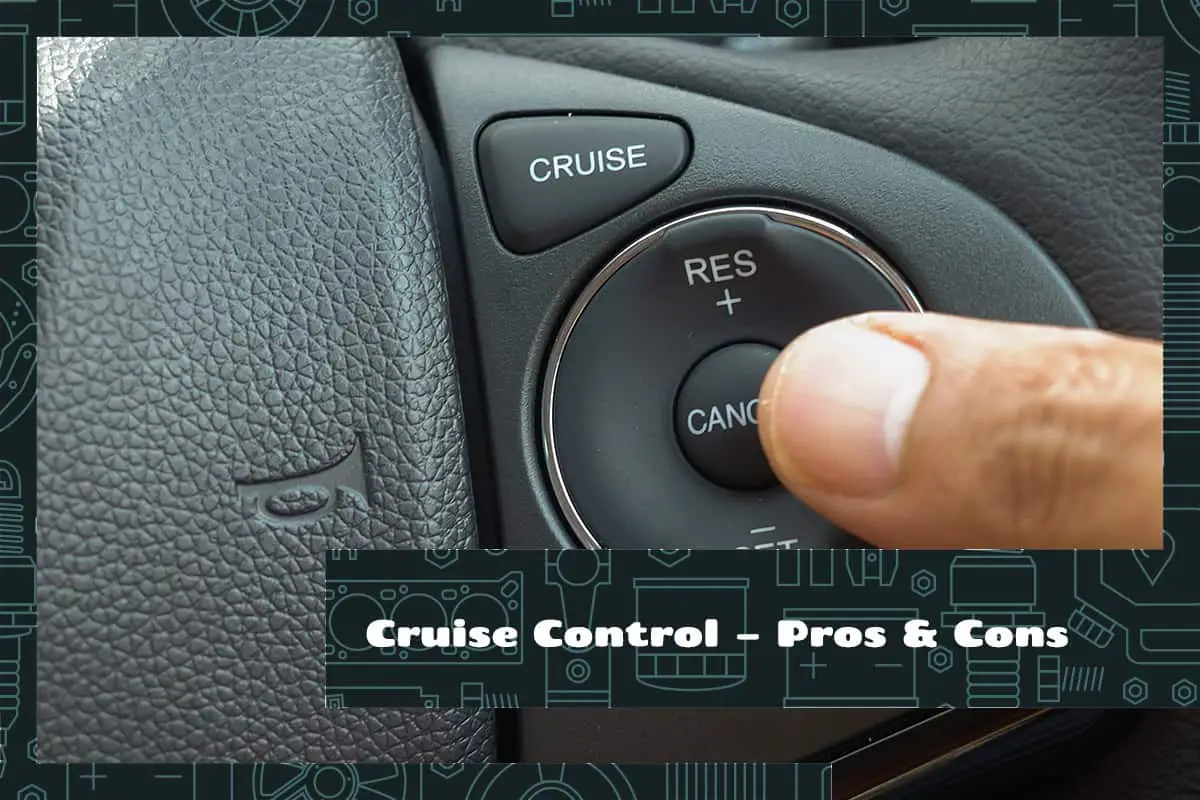
Cruise control is a smart feature in modern cars that lets you set a specific speed your car will maintain without you having to keep your foot on the gas pedal. It’s sort of like setting a pace for a marathon, so you don’t have to think about it constantly.
Here is a quick breakdown of the pros and cons of cruise control:
- Pros: Increased fuel efficiency, reduced driver fatigue, consistent speed maintenance, fewer speeding violations.
- Cons: Potential inattentiveness, inefficiency in city driving, risks in adverse weather, compatibility issues with older vehicles.
In this article, we’ll dig deeper into these advantages and disadvantages and explore the next-generation Adaptive Cruise Control.

A Quick Look at Cruise Control
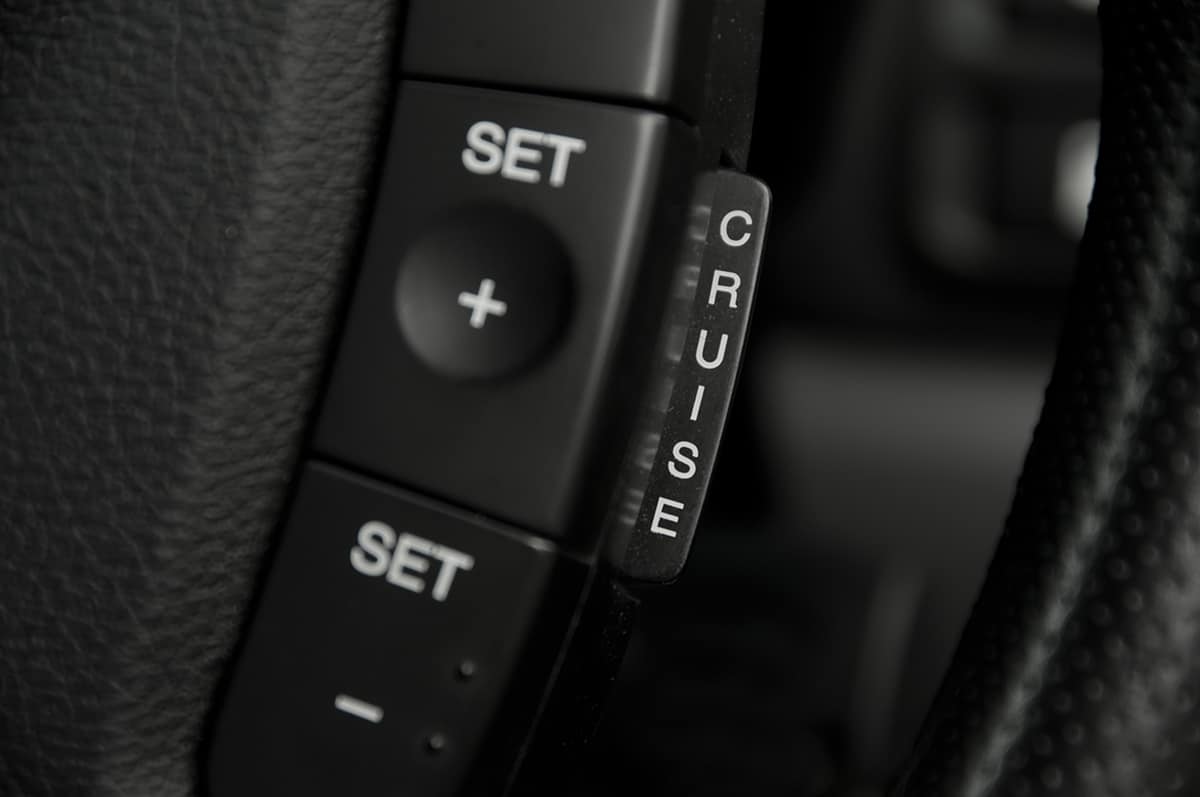
The cruise control system relies on a speedometer and a servo mechanism to work. When you set a speed, the system maintains it by controlling the throttle. If your car goes slower than the set speed, like going up a hill, the system increases throttle to speed up. When going downhill, it reduces throttle to slow down, keeping your car at the same speed you set.
The first rudimentary versions of cruise control appeared in the late 19th century, but the modern version was invented in the 1940s by Ralph Teetor , a blind mechanical engineer. His goal was to stop the jerky speed adjustments made by his chauffeur, which led to the invention of “Speedostat”, later known as cruise control.
Cruise control quickly became popular, especially for highway driving, and was a standard feature in many cars by the 1990s. Over time, technological advancements led to the development of more sophisticated systems. One of these is Adaptive Cruise Control , a more advanced type of cruise control that can automatically adjust the car’s speed to maintain a safe distance from vehicles ahead.
The Advantages of Cruise Control
Cruise control comes with several advantages that make driving not just easier but also safer and more efficient. Let’s look into these benefits in detail.
1. Increased fuel economy
Fuel efficiency is one of the significant benefits of using cruise control. When you manually control your car’s speed, it’s natural to have variations, leading to more fuel consumption. The cruise control maintains a steady speed, reducing fuel usage , especially on long highway drives. This is good for both your wallet and the environment!
2. Reduced driver fatigue
Long hours on the road can make drivers tired and less focused. Cruise control helps by taking over speed management, letting drivers relax their feet and concentrate more on steering and observing the road. This reduces fatigue , helping you stay alert and safer on your journey.
3. Consistent speed maintenance
Humans naturally struggle to maintain a constant speed while driving, especially over long distances. Cruise control, being a computerized system, can keep your car at a steady pace. This consistency makes your driving smoother and even contributes to smoother traffic flow when multiple vehicles use cruise control.
Cruise control is particularly beneficial on highways. Highways are typically long, straight roads with less traffic and few stops. These conditions are perfect for cruise control. By maintaining a constant speed, it aids in overall traffic management and reduces the risk of speeding.
4. Fewer speeding violations
A great benefit of cruise control is that it helps prevent speeding tickets. Since you set a maximum speed for your car , cruise control ensures you don’t accidentally go over the limit. It’s an excellent tool for keeping yourself within the law while also reducing the risk of speed-related accidents.
The Disadvantages of Cruise Control
While cruise control has many advantages, it’s not perfect. There are some disadvantages to consider, especially when it comes to city driving, weather conditions, and the age of your vehicle.
1. Potential inattentiveness
While cruise control can help with driver fatigue, there’s also a risk of becoming too relaxed . Some drivers may pay less attention to the road, thinking that cruise control is doing all the work. Remember, cruise control only manages speed. You still need to steer, brake, and stay alert.
2. Inefficiency in city driving
Cruise control is ideal for highways, but it’s less effective in the city. City driving often involves frequent stops, sudden speed changes, and navigating around other vehicles or pedestrians. Cruise control can’t handle these complexities, so manual control is better in these situations.
3. Risks in adverse weather
Cruise control is not recommended in bad weather conditions , like rain, snow, or icy roads. These situations require delicate control over your vehicle, something cruise control can’t provide. Using it in such conditions can increase the risk of losing control or hydroplaning.
4. Compatibility issues with older vehicles
While most new cars come with cruise control, older models might not have this feature. Even if you can install it, it might not work as efficiently as in newer cars. Also, the installation can be expensive, and there’s a risk of damaging the vehicle if not done correctly.
Practical Tips for Cruise Control
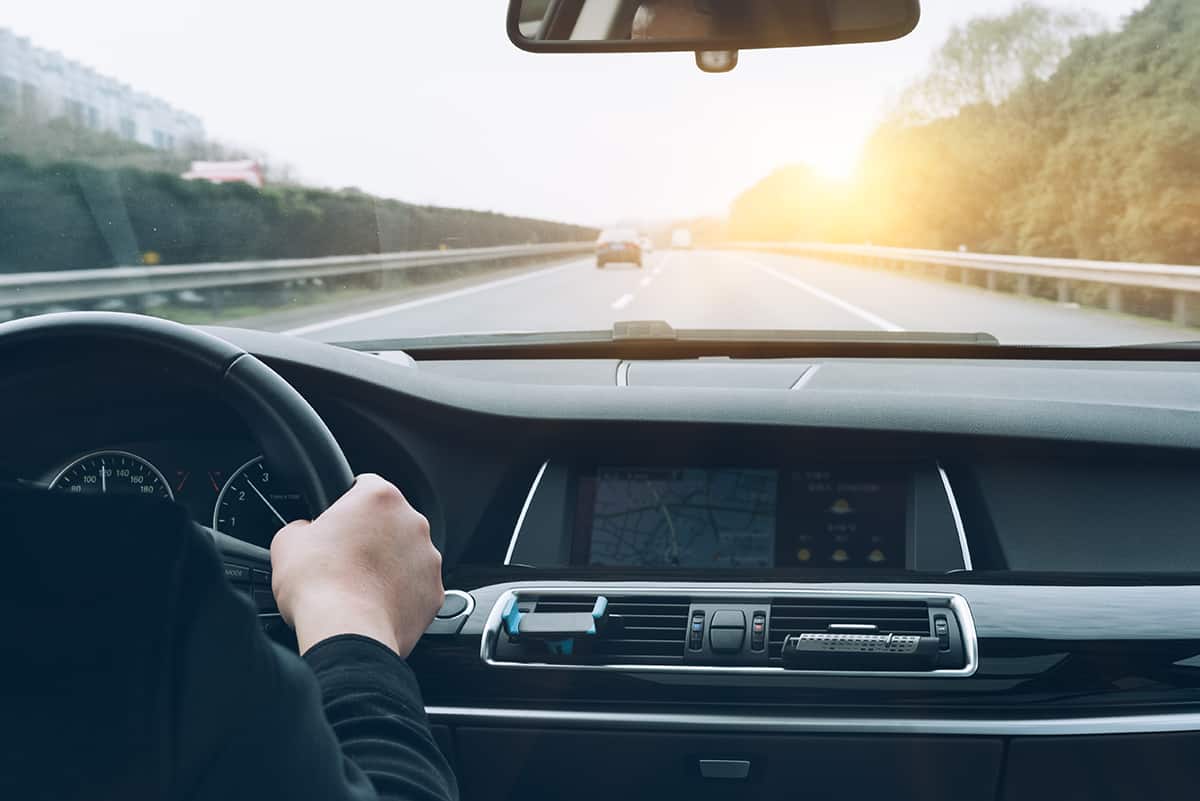
Cruise control is a handy tool, but it requires proper use to reap its benefits. Here are some practical tips to ensure you’re using cruise control effectively and safely:
- Know when to use it : Cruise control is best for long, straight roads with consistent traffic, like highways. Avoid using it in heavy traffic, poor weather conditions, or on curvy or hilly roads.
- Stay alert : Cruise control is not an autopilot. You still need to stay focused on the road, ready to brake, steer, or take over speed control if necessary.
- Set a reasonable speed : Don’t set your cruise control at a speed that’s too fast for the conditions. Always adhere to speed limits and adjust your speed to the traffic, road, and weather conditions.
- Use it to save fuel : By maintaining a consistent speed, cruise control can help improve your car’s fuel efficiency, particularly on long drives.
- Understand its limitations : Cruise control cannot recognize stop signs, traffic lights, or other road hazards. That’s your job. Always be prepared to disengage cruise control quickly if needed.
Adaptive Cruise Control: The Next Generation
Adaptive Cruise Control is a newer, more advanced version of traditional cruise control. Just like its predecessor, Adaptive Cruise Control can maintain a set speed. But it also does something more—it can automatically adjust the speed of your car to keep a safe distance from the vehicle in front of you. Let’s delve into the pros and cons of this innovative technology.
The evolution of traditional cruise control
Unlike regular cruise control, Adaptive Cruise Control uses advanced sensors and sometimes cameras to watch the road ahead. If the car in front slows down, this system slows your car, too, maintaining the safe gap. When the road clears again, Adaptive Cruise Control speeds up back to your set speed. This means you can turn this feature on even in moderate traffic, a huge step up from traditional cruise control.
Advantages of Adaptive Cruise Control
Adaptive Cruise Control brings a new level of safety and convenience to driving. It can help prevent collisions by maintaining a safe following distance, reducing the stress of driving in heavy traffic. It also allows you to relax more without worrying about adjusting your speed frequently. But remember, even with Adaptive Cruise Control, you need to stay alert and ready to react if needed.
Disadvantages of Adaptive Cruise
Despite its benefits, Adaptive Cruise Control also has some drawbacks. For one, it’s usually more expensive both to purchase a new car and to repair if something goes wrong. Some drivers may find the cost not worth the added benefits.
Additionally, while Adaptive Cruise Control technology is pretty smart, it’s not perfect. It might not react to stopped vehicles or non-moving objects like a manual driver would. It can also be thrown off by bad weather or dirty sensors.
1. Do cruise control save gas?
Yes, cruise control can save gas. By maintaining a consistent speed, it helps your car use fuel more efficiently, especially during long drives on the highway. This efficiency decreases when roads are hilly or you’re stopping and starting a lot, like in city driving.
2. Should you use cruise control in the rain?
No, using cruise control in the rain is not advised. Wet conditions make roads slippery, requiring you to adjust your speed often and sometimes quite suddenly. Cruise control isn’t able to make these quick, necessary adjustments. Using it could increase the risk of losing control of your car or hydroplaning.
3. Is adaptive cruise control worth it?
The worth of Adaptive Cruise Control depends on your driving conditions and personal preferences. If you often drive on highways or in moderate traffic, ACC can be a big help. It adjusts your car’s speed to keep a safe distance from the car in front, reducing stress and enhancing safety. However, getting ACC for your car often costs more, so consider your budget too.
4. Is adaptive cruise control safe?
Yes, Adaptive Cruise Control can improve safety by maintaining a safe distance from the car in front of you. However, it doesn’t eliminate the need for you to be alert and ready to take control at any moment. It’s a support tool, not a substitute for active, responsible driving. Like any tech, it might have occasional glitches, so always keep your eyes on the road.
5. When to use cruise control?
Cruise control is best used on long, straight stretches of road, like highways, where you don’t need to stop frequently. It’s great for maintaining a constant speed, which can prevent speeding tickets and improve fuel efficiency. However, avoid using cruise control in heavy traffic, bad weather, or on curvy or hilly roads. Always stay fully alert, even when using cruise control.
Related Articles


Cruise Control Advantages and Disadvantages
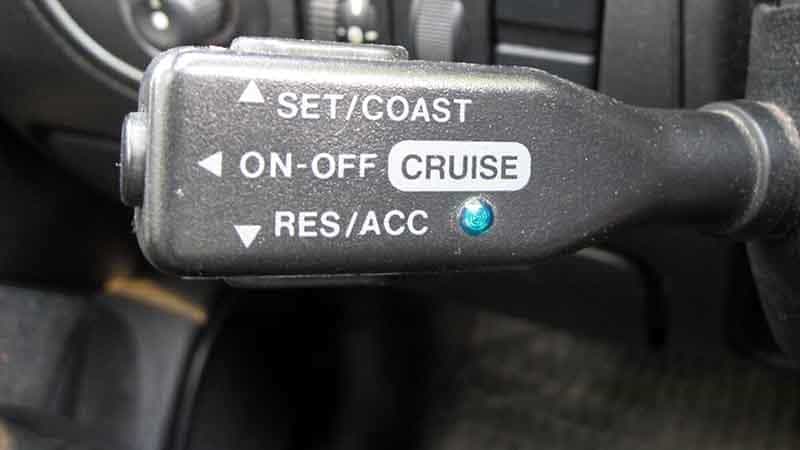
Cruise control is a system that almost every modern vehicle on the road today has as a feature. The purpose of the cruise control system is to give drivers the ability to automatically set and maintain a specific vehicle speed.
That way, when you take your foot off the gas pedal, your car will continue driving at the speed in which it was set to.
You have the option to easily deactivate cruise control simply by stepping (a slight tap will do) on the brake pedal or via some form of “cancel” button/stalk/lever in the cruise “control” area. This will cause the acceleration to go back to manual control once again.
Drivers can manage cruise control right from their steering wheel. You will find the cruise control buttons either on the front of the steering wheel or to the side of it on the stalk or lever where the windshield wiper or turn signal controls are.
What you’ll first want to do is manually accelerate to a speed that you’ll want to maintain for a long distance. Once you reach that speed, you will push the “ON” button (or some combination of “on” and “set”) to activate cruise control. Then you can take your foot off the gas pedal and rest it on the floor.
With some forms of cruise control, the gas pedal will maintain the same pressed position without your foot having to be on it. Once you turn cruise control off by either pressing the off button or stepping on the brake pedal, the gas pedal will come back up again.
Related: 7 Reasons Cruise Control Isn’t Working
Table of Contents
Top 3 Cruise Control Advantages
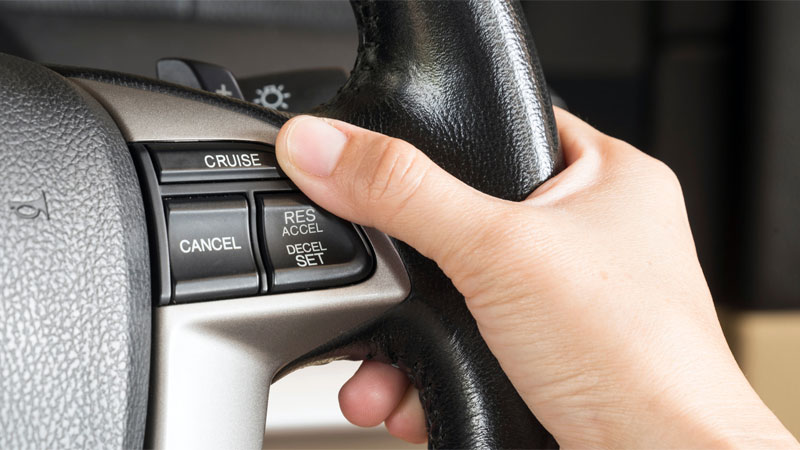
1) Good Fuel Economy
When you apply pressure to the gas pedal, it burns fuel. Cruise control keeps the gas pedal in one position so that you are not inadvertently consuming more fuel than you need to. This helps optimize your fuel economy (in most cases).
However, if driving through an area with various elevation changes, cruise control can actually use more fuel as you’ll naturally lose speed driving up inclines.
Because the vehicle doesn’t want to deviate from the set cruise control speed, it will in essence “mash the gas pedal” to get up to the cruise control speed as quickly as possible. Wide open throttle (WOT) like this will use more fuel than gradually increasing pressure on the gas pedal.
2) Better Driving Comfort
If you are going on a long drive, it can get tiring to have to keep your foot on the gas pedal for several hours on end. This is what a lot of drivers experience when they’re driving for long stretches on the highway.
With cruise control, you can rest your foot on the floor as the vehicle keeps moving at one steady speed. This will also lower your chances of dealing with fatigue as well.
Those suffering from lower back or leg pain may take a few seconds to stretch their legs out (if room allows).
3) Avoid Speeding
Speeding is not always intentional. A driver may go faster than the speed limit because they’re pressing harder on the gas pedal without realizing it.
A good way to avoid speeding is by setting the cruise control to the posted speed limit (or slightly over). Then you don’t have to worry about violating the speeding laws.
If on a multi-lane highway, you should in general avoid using the left lane unless you are passing a slower moving vehicle. This is even more important when utilizing cruise control.
Top 4 Cruise Control Disadvantages

1) Bad for Tired Drivers
If you are feeling tired and sleepy behind the steering wheel, then cruise control is not going to help. In fact, it will make it easier for you to fall asleep behind the wheel because you won’t have to do much work as a driver.
This will almost certainly increase your odds of causing a traffic accident. It’s best to simply get off the road at the next available opportunity when you start feeling sleepy but at the very least, don’t use cruise control.
2) Harder to Slow Down Quickly
If you have cruise control set and find that you need to make a turn within a few seconds, you won’t be able to slow down the vehicle fast enough to make the turn. It is also harder to avoid hitting other vehicles on the road that are close to you.
3) Harder to Drive in Bad Weather
Cruise control can cause your tires to lose traction on the road if the weather conditions are snowy, wet, or icy. For instance, if you seed a lightly flooded area in the road up ahead, it will be hard to slow down and avoid it with cruise control on. Your car could hydroplane, skid, or slide if the road conditions continue to be bad.
Simply put, don’t use cruise control in less-than-optimal driving conditions.
Read also: Advantages and Disadvantages of the Duramax Diesel Engine
4) Easier to Get Distracted
Drivers using cruise control will be more tempted to look at their smartphones or other electronic devices. Even though they still need to steer, they don’t have to devote as much brainpower toward accelerating the vehicle.
This makes them feel more comfortable to do other things besides looking at the road. This is a recipe for disaster so put the phone away!
- Recent Posts
- Power Windows Not Working? (10 Common Causes and How to Fix) - February 8, 2024
- 14 Causes of a Car Losing Power When Accelerating - January 23, 2024
- 13 Causes of Poor Gas Mileage (Increase Your MPG) - December 13, 2023
Leave a Comment Cancel reply
Free Consultations 24/7
Pros and Cons of Using Cruise Control While Driving
Do you have a case.
Home > Blog > Pros and Cons o...
According to Consumer Reports, more than 90% of new vehicles have adaptive cruise control. Unlike previous versions of cruise control, adaptive cruise control helps vehicles not only maintain a steady speed, but also a safe following distance behind other vehicles and not exceed the speed limit as it changes.
Whether you drive a vehicle with adaptive cruise control or an older vehicle with standard cruise control, you may enjoy using the feature, especially on long drives or during your daily commute. Using cruise control can make your drive easier, but it also comes with a few drawbacks that all drivers should be aware of.
Here are a few pros and cons to keep in mind the next time you think about using your vehicle’s cruise control function.
Pro: It Can Increase Your Vehicle’s Fuel-Efficiency
Both standard and adaptive cruise control can help your vehicle consume less fuel on a trip. That’s because your vehicle is better at maintaining a steady speed than you are, which makes it use gas more efficiently. Adaptive cruise control is even more efficient than standard cruise control, as it can reduce the need for braking and accelerating in response to the behaviors of drivers in front of you.
And while the savings may not be much per trip, they can quickly add up over time. They can also make a difference in your total fuel bill when you’re on long trips, especially on flat, straight highways and interstates with relatively little traffic.
Con: It Can Make Drivers Less Aware and Prepared
Driving is a mentally taxing task. It requires staying focused on the road and the movements of other vehicles. That means accelerating and braking at appropriate times and distances, being aware of your vehicle’s size and power, and keeping its movement steady.
When you use cruise control, you are no longer giving your full mental and physical attention to the task of driving. When driving on straight stretches of road with cruise control activated, you may not even need to steer constantly. That can increase your risk of daydreaming, becoming distracted, or suffering from “highway hypnosis”—all of which can make it more difficult to react immediately in the event of a potential crash situation, such as an animal darting into the road, encountering road debris, or another driver behaving erratically.
Pro: It Can Reduce Your Chances of Getting a Speeding Ticket
You’ve probably heard jokes about drivers “having a lead foot,” but accidentally speeding is a common traffic law violation. To maintain your speed, you need to keep your foot on the gas pedal. If you’re not paying close attention to your speedometer, it’s easy to exceed the speed limit by 5, 10, or even 15 MPH and not realize it.
When you use cruise control, there’s less chance you’ll exceed the speed limit, especially if it’s consistent for a long stretch. That’s because cruise control maintains the speed you set until you turn it off. Adaptive cruise control is even more effective, as it will automatically reduce your speed in response to speed limit changes.
Con: It Can Cause Unexpected Results in Inclement Weather
Cruise control should only be used when visibility is good and when the roads are dry and clear. That’s because drivers still need to be aware of what’s going on around them and because cruise control is less effective at maintaining a steady speed on slick asphalt, like happens when it rains.
Even adaptive cruise control may struggle to perform safely and efficiently at night or during bad weather. When any type of cruise control is activated, your vehicle may not properly adapt to increased braking distances during rainstorms or winter weather. That means that if you rely on it to slow down or maintain a safe speed, it may brake too late or accelerate too early, causing a crash.
New Technology and Safety Features Don’t Excuse Drivers from Responsibility
Today’s vehicles are smarter and safer than ever. But most vehicles still need to be driven by actual drivers, and those drivers are responsible when their vehicles are involved in accidents. That means drivers should use technology only when appropriate and safe to do so, and continue to stay focused on the road at all times—even when cruise control is activated.
When drivers are overly reliant on technology and fail to uphold their duties to themselves and other drivers, serious crashes can occur. And when they do, our Ohio car accident lawyers are here to help. Contact Nurenberg, Paris, Heller & McCarthy today if you or someone you love was hurt in a crash that wasn’t your fault. We want to help you get maximum compensation.
Related Posts
The role of occupational therapists in workers’ compensation rehabilitation.
Getting hurt at work can change your life in an instant. Not only are you suddenly in severe pain, but you will now have medical bills to pay. You may even worry about when or if you can return to work. Workers’ compensation benefits help injured workers solve these problems. Rehabilitation is an important part […]
PRESS RELEASE: Cleveland Law Firm Files Wrongful Death Lawsuit Over Dangerous Supplement
Nurenberg, Paris, Heller & McCarthy Take Legal Action Against Manufacturers of Neptune’s Fix Following Death of Local Man CLEVELAND (June 26, 2024) — Nurenberg, Paris, Heller & McCarthy, a Cleveland-based law firm, filed the first wrongful death lawsuit linked to taking Neptune’s Fix on June 4, 2024, in Lorain County Court of Common Pleas (case […]
What Is Ohio’s Lane Splitting Law for Motorcyclists?
Ohio law doesn’t specifically ban or condone lane splitting or lane filtering by motorcyclists. However, that doesn’t mean there’s no risk of a ticket involved. Motorcyclists who lane split often receive citations for other related offenses, such as improper lane changes or failure to maintain a lane. In addition, Ohio law says that motorcyclists must […]
How to Ride Your Motorcycle Safely in a Group of Riders
One of the biggest perks of owning a motorcycle is enjoying the community and camaraderie of being a motorcyclist. Whether you connect with other bikers over riding the same type of motorcycle or simply through a shared love of riding, heading out on Ohio’s roads in a group can add fun and excitement to an […]
How to Protect Yourself if You Aren’t Eligible for Workers’ Comp
Workers’ compensation in Ohio offers important financial protection for employees who are injured or contract illnesses as a result of their job duties. However, not all workers can receive workers’ compensation benefits, even if they get injured at work. Independent contractors, volunteers, and some other categories of workers are ineligible for workers’ comp benefits in […]

- February 2024
- January 2024
- December 2023
- November 2023
- October 2023
- September 2023
- August 2023
- Advisories & Tips
- Apps & Software
- Buyer's Guide
- Maintenance

Cruise Control: How it Works, Types and Everything You Should Know
Learn how to effectively use cruise control in your vehicle. follow our simple instructions to optimize your driving experience.
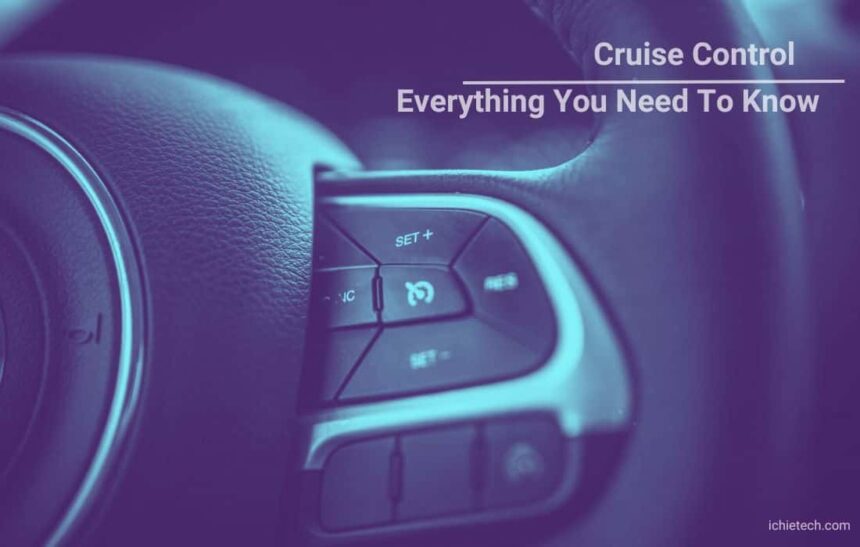
Cruise control is a popular feature in modern vehicles that can make driving more comfortable and less stressful. There are several types of cruise control systems that drivers can choose from, depending on their driving conditions and preferences. Standard cruise control is the most basic system, which allows the driver to set a constant speed that the vehicle will maintain. Adaptive cruise control, on the other hand, uses sensors to detect the distance and speed of vehicles in front of the car, adjusting the vehicle’s speed accordingly to maintain a safe following distance.
Intelligent cruise control goes even further, using artificial intelligence to learn the driver’s behaviour and adjust the speed of the vehicle before the driver takes action. Stop-and-go cruise control is ideal for use in heavy traffic and can bring the vehicle to a complete stop if necessary, while speed limiters are designed to limit the maximum speed of the vehicle. Each type of cruise control system has its own advantages and disadvantages, and drivers should choose the one that best suits their needs.
What Is Cruise Control
Cruise control is a system within a vehicle that enables drivers to establish and sustain a specific speed without having to continuously press the accelerator pedal. The system uses electronic sensors to track the vehicle’s speed and automatically regulate the throttle and brakes to maintain the predetermined speed. Cruise controle is generally employed during extended trips on highways, where sustaining a constant speed can decrease driver tiredness and boost fuel economy. It is a common feature in modern automobiles, trucks, and other types of vehicles.
How it Works
Cruise control works by using a combination of electronic sensors, servos, and control algorithms to maintain a vehicle’s speed without requiring the driver to continuously press the accelerator pedal. Here is a step-by-step breakdown of how cruise controle works:
- The driver activates cruise control by pressing a button or flipping a switch on the dashboard or steering wheel.
- The system uses electronic sensors to measure the vehicle’s speed and other factors such as throttle position, engine load, and road grade.
- The driver sets the desired speed by pressing a button or using a lever. The speed is usually displayed on the dashboard.
- Once the speed is set, the cruise controle system takes over and maintains the speed by sending signals to the throttle and brakes as necessary.
- If the vehicle encounters an incline or decline, the cruise control system adjusts the throttle to maintain a constant speed.
- If the driver needs to slow down or stop, they can deactivate the cruise control by pressing the brake or clutch pedal, or by turning off the system using the control button.
In some modern cars, the cruise control system is enhanced with additional sensors and algorithms that enable it to adapt to the surrounding traffic and road conditions. These advanced systems are known as adaptive cruise control, intelligent cruise control, or active cruise control.
How To Use Cruise Control
Cruise control is a feature commonly found in modern vehicles that allows the driver to maintain a constant speed without having to keep their foot on the accelerator pedal. Here’s how to use cruise control:
- Locate the cruise control button : The button is typically located on the steering wheel or dashboard. Check your owner’s manual if you’re having trouble finding it.
- Activate cruise control : Once you’ve found the cruise control button, press it to turn on the system. You should see a light on the dashboard indicating that cruise control is active.
- Accelerate to your desired speed : Using the accelerator pedal, accelerate to the speed you want to maintain.
- Set the speed : Press the “set” or “res” button on the steering wheel to set the speed. The vehicle will maintain this speed until you cancel cruise control or apply the brakes.
- Adjust the speed : To increase or decrease your speed, use the “+” or “-” buttons on the steering wheel.
- Cancel cruise control : To turn off cruise control, press the “off” or “cancel” button on the steering wheel, or press the brake pedal.
- Resume cruise control : If you cancel cruise control but want to resume it at the previous speed, press the “resume” button on the steering wheel.
Note: Always remember to pay attention to the road and adjust your speed as needed. Do not rely solely on cruise control while driving.
Advantages Of Cruise Control
- Reduces driver fatigue : With cruise control engaged, the driver does not have to maintain constant pressure on the accelerator pedal. This can help reduce driver fatigue, particularly during long trips.
- Conserves fuel : Cruise control helps maintain a consistent speed, which can result in better fuel efficiency. This is because the vehicle is not accelerating and decelerating as frequently, which can waste fuel.
- Helps avoid speeding tickets : Cruise control can help drivers avoid speeding tickets, as they can set the desired speed and avoid accidentally exceeding the speed limit.
- Improves safety : Maintaining a consistent speed with cruise control can help reduce the likelihood of sudden braking or acceleration, which can improve safety on the road.
- Enhances driving experience : Cruise control can make driving more comfortable and less stressful, particularly in heavy traffic or on long trips.
Disadvantages Of Cruise Control
- Limited use : Cruise controle is best suited for use on highways or other roads with minimal traffic and few curves. It may not be appropriate for use in heavy traffic or on winding roads, as it may not respond quickly enough to changing driving conditions.
- Increases risk in hazardous conditions : Using cruise controle in hazardous conditions such as rain, ice, or snow can be dangerous. The driver may not be able to react quickly enough to changing conditions, and the vehicle may lose traction or spin out of control.
- Can lead to complacency : Relying too heavily on cruise controle can lead to complacency and inattention while driving. The driver may become less aware of their surroundings or less attentive to the road.
- May cause speed variations : Cruise controle may cause speed variations due to changes in road elevation, wind, or traffic conditions. This can be a problem if the driver is not paying attention and fails to adjust the speed manually.
- May reduce driver engagement : Using cruise controle for extended periods of time may reduce driver engagement and enjoyment of the driving experience.
Types Of Cruise Control
Modern vehicles offer various types of cruise control systems to assist drivers in maintaining a steady speed. Here are some of the most common types of speed control.
1. Standard Cruise Control
Standard cruise control is the most basic form of speed control system that has been around for several decades. It allows the driver to set a desired speed and maintain it without having to keep their foot on the accelerator pedal. Once activated, the system uses electronic sensors to monitor the speed of the vehicle and automatically adjusts the throttle to maintain a constant speed.
With standard cruise controle, the vehicle will maintain the set speed regardless of changes in the road conditions, such as uphill or downhill slopes or curves. To deactivate the system, the driver can either apply the brakes or turn off the cruise control switch. Standard cruise controle can be found on many vehicles, from entry-level models to high-end luxury cars.
While it can help reduce driver fatigue and improve fuel economy on long drives, it requires the driver to remain attentive and adjust the speed manually if necessary. Therefore, it is important for drivers to use it responsibly and not rely solely on the system to maintain a safe driving experience.
Advantages of Standard Cruise Control
- Reduced driver fatigue : By allowing the driver to set a constant speed and not having to keep their foot on the accelerator pedal, standard cruise control can help reduce driver fatigue and make long drives more comfortable.
- Improved fuel efficiency : Maintaining a constant speed using cruise controle can improve fuel efficiency by reducing unnecessary acceleration and deceleration, resulting in lower fuel consumption.
- Avoiding speeding tickets : Standard cruise control helps drivers avoid unintentionally exceeding the speed limit, which can result in costly speeding tickets.
- Easier driving in heavy traffic : When driving in heavy traffic, using cruise controle can help reduce stress and allow drivers to focus on other aspects of driving, such as changing lanes and looking out for other drivers.
- Consistent speed : By maintaining a consistent speed, standard cruise controle can provide a smoother driving experience, especially on long, open roads where it can be challenging to maintain a constant speed manually.
Disadvantages Of Standard Cruise Control
- Limited functionality : Standard cruise control can only maintain a constant speed and does not adjust the speed based on traffic or road conditions. As a result, drivers must be attentive and make manual adjustments if necessary, especially in situations such as steep hills, winding roads, or heavy traffic.
- Reduced control : By taking over the throttle, standard cruise controle can reduce the driver’s control over the vehicle, particularly in emergency situations that require quick acceleration or deceleration.
- Safety risks : Standard cruise controle may pose a safety risk in some situations, such as when driving on wet or icy roads, where sudden changes in road conditions could cause the vehicle to skid or lose control.
- Increased fuel consumption : In some cases, standard cruise controle can actually increase fuel consumption, particularly in stop-and-go traffic, where frequent acceleration and deceleration can lead to higher fuel consumption than maintaining a constant speed.
- Maintenance and repair costs : If the cruise controle system malfunctions, it can be costly to repair or replace.
2. Adaptive Cruise Control
Adaptive Cruise Control (ACC) is an advanced form of speed control that uses sensors and radar to detect the distance between the driver’s car and the vehicle ahead, unlike other types of cruise control systems. This type of cruise control automatically adjusts the speed of the vehicle to maintain a safe following distance and can even bring the vehicle to a complete stop if necessary.
The system uses sensors and radar to detect the distance between the driver’s car and the vehicle ahead. If the vehicle ahead slows down or stops, the ACC system automatically applies the brakes to slow down or stop the car, maintaining a safe distance. When the road clears or the vehicle ahead moves faster, the ACC system accelerates the car to the driver’s set speed or the maximum speed limit.
Some ACC systems also come with collision warning systems that alert the driver if the car gets too close to the vehicle ahead. Some systems can also detect pedestrians, animals, or other obstacles and apply the brakes if necessary.
Advantages Of Adaptive Cruise Control
- Enhanced safety : By automatically maintaining a safe distance from the vehicle ahead, adaptive cruise control can help reduce the risk of rear-end collisions, making it a valuable safety feature.
- Reduced driver fatigue : Adaptive speed control can reduce driver fatigue by taking over the task of maintaining a safe following distance, especially in heavy traffic.
- Increased convenience : ACC can make long drives more comfortable and less stressful, as the driver doesn’t have to constantly adjust the speed.
- Fuel efficiency : By maintaining a constant speed and reducing unnecessary acceleration and deceleration, adaptive cruise control can help improve fuel efficiency.
Disadvantages Of Adaptive Cruise Control
- High cost : ACC systems are more expensive than traditional cruise control systems.
- Limited functionality : ACC may not work in all driving situations, such as on winding roads or in heavy rain or snow.
- Over-reliance : Drivers may become too reliant on the ACC system and neglect to pay attention to the road and other vehicles, which can lead to accidents.
- Complex operation : ACC systems can be complex and difficult to operate, requiring drivers to understand how the system works and how to use it correctly.
3. Intelligent Cruise Control
Intelligent Cruise Control (ICC), also known as Active Cruise Control (ACC), is an advanced form of cruise controle that uses sensors and cameras to detect the distance and speed of the vehicles ahead. ICC not only maintains a safe distance from the vehicle ahead but also adjusts the speed of the vehicle to match the flow of traffic.
The system uses a forward-facing camera and sensors to detect the speed and distance of the vehicle in front of the driver. If the vehicle ahead slows down or speeds up, ICC automatically adjusts the speed of the driver’s car to maintain a safe following distance. Unlike regular speed control, ICC can also bring the car to a complete stop and resume driving when the vehicle ahead starts moving again.
ICC systems can also recognize lane markings and keep the car centred within the lane, providing additional safety and convenience benefits. Some ICC systems can even detect and respond to pedestrians and other obstacles, providing an added layer of safety.
Advantages Of Intelligent Cruise Control
- Increased safety : By automatically adjusting the speed and maintaining a safe following distance, ICC can help prevent accidents and reduce the risk of collisions.
- Reduced driver fatigue : ICC can reduce driver fatigue and make long drives more comfortable, especially in heavy traffic.
- Improved fuel efficiency : By maintaining a constant speed and reducing unnecessary acceleration and deceleration, ICC can help improve fuel efficiency.
- Enhanced convenience : ICC can make driving more convenient and less stressful, as the system takes care of maintaining a safe distance and speed.
Disadvantages Of Intelligent Cruise Control
- High cost : ICC systems can be expensive, especially in luxury cars.
- Complex operation : ICC systems can be complex and difficult to operate, requiring drivers to understand how the system works and how to use it correctly.
- Limited functionality : ICC may not work in all driving situations, such as on winding roads or in heavy rain or snow.
- Over-reliance : Drivers may become too reliant on the ICC system and neglect to pay attention to the road and other vehicles, which can lead to accidents.
4. Stop-and-Go Cruise Control
Stop-and-Go Cruise Control is an advanced form of speed control, Unlike other types of cruise controle systems. It can maintain a safe distance from the vehicle ahead, even in stop-and-go traffic. This type of cruise controle is designed to help drivers reduce stress and fatigue when driving in heavy traffic conditions. The system uses sensors and cameras to detect the distance and speed of the vehicle ahead.
When traffic slows down or comes to a stop, the Stop-and-Go Cruise Control system automatically applies the brakes to bring the car to a complete stop. When the traffic ahead starts moving again, the system automatically accelerates the car to follow the flow of traffic.
Stop-and-Go speed control systems can help reduce the stress and fatigue of driving in heavy traffic, as the system takes care of maintaining a safe distance and speed. Some systems also have the ability to recognize and respond to pedestrians and other obstacles, providing an added layer of safety.
Advantages Of Stop-and-Go Cruise Control
- Reduced driver fatigue : Stop-and-Go Cruise controle can reduce driver fatigue and make long drives in heavy traffic more comfortable.
- Increased safety : By automatically adjusting the speed and maintaining a safe following distance, Stop-and-Go Cruise controle can help prevent accidents and reduce the risk of collisions.
- Enhanced convenience : Stop-and-Go speed control can make driving in heavy traffic more convenient and less stressful, as the system takes care of maintaining a safe distance and speed.
- Improved fuel efficiency : By maintaining a constant speed and reducing unnecessary acceleration and deceleration, Stop-and-Go Cruise controle can help improve fuel efficiency.
Disadvantages Of Stop-and-Go Cruise Control
- Limited functionality : Stop-and-Go speed control may not work in all driving situations, such as on winding roads or in heavy rain or snow.
- High cost : Stop-and-Go speed control systems can be expensive, especially in luxury cars.
- Complex operation : Stop-and-Go speed control systems can be complex and difficult to operate, requiring drivers to understand how the system works and how to use it correctly.
- Over-reliance : Drivers may become too reliant on the system and neglect to pay attention to the road and other vehicles, which can lead to accidents.
5. Speed Limiter
A speed limiter is a type of speed control system that is designed to limit the maximum speed of a vehicle. Unlike other types of cruise control systems, which maintain a set speed, a speed limiter prevents a vehicle from exceeding a certain speed limit.
Speed limiters can be installed in vehicles as a safety feature, particularly in commercial vehicles like trucks and buses. These vehicles are often required by law to have speed limiters installed, as they can help prevent accidents caused by excessive speed. In addition, speed limiters can help improve fuel efficiency and reduce wear and tear on the vehicle’s engine and brakes.
There are two main types of speed limiters :
Hard limiters : These limiters prevent a vehicle from exceeding a certain speed limit, typically set by the manufacturer. Once the limit is set, it cannot be exceeded, even in emergency situations. Soft limiters : These limiters allow the vehicle to exceed the set speed limit in certain situations, such as when overtaking or accelerating to merge onto a highway. However, the limiter will still prevent the vehicle from exceeding the maximum speed limit.
Advantages Of Speed Limiter
- Increased safety : Speed limiters can help prevent accidents caused by excessive speed, especially in commercial vehicles.
- Reduced fuel consumption : By limiting the maximum speed of a vehicle, speed limiters can help improve fuel efficiency.
- Reduced wear and tear : Speed limiters can help reduce wear and tear on a vehicle’s engine and brakes, extending the life of the vehicle.
- Compliance with regulations : In some countries, commercial vehicles are required by law to have speed limiters installed.
Disadvantages Of Speed Limiter
- Limited functionality : Speed limiters may not be effective in preventing all types of accidents or speeding violations.
- Reduced driver control : Some drivers may feel uncomfortable with a speed limiter installed, as it restricts their ability to control the vehicle’s speed.
- Maintenance costs : Speed limiters may require maintenance and calibration, which can be costly.
It’s important to remember that cruise control is not a substitute for attentive driving. Drivers should always remain aware of their surroundings and be ready to take control of the vehicle at any time. Additionally, drivers should not use speed control in certain situations, such as in heavy traffic, on wet or slippery roads, or when driving in mountainous terrain. Overall, it can be a helpful tool for long-distance driving on open roads, but drivers should always use it with caution and be aware of its limitations.
You Might Also Like
2023 toyota camry: features, specs and price in nigeria, 10 cheap cars with hidden fuel efficiency you should know, 2022 toyota camry: features, specs and price in nigeria, top 10 best cars for women to buy in nigeria (2024), 10 most affordable family cars in nigeria, sign up for daily newsletter, be keep up get the latest tech and auto news delivered straight to your inbox..
Email address:
Leave a Reply Cancel reply
Your email address will not be published. Required fields are marked *
Save my name, email, and website in this browser for the next time I comment.
Stay Connected
Latest news.

Xiaomi Redmi A3 Review: Specs and Price in Nigeria

How to Check Car Registration Status in Nigeria

Binance in Trouble: Nigeria Demands Massive $10B Fine

Infinix Hot 40 Pro Review: Specs and Price in Nigeria
Recent comments.
Sign in to your account
Username or Email Address
Remember Me

Its about auto solutions
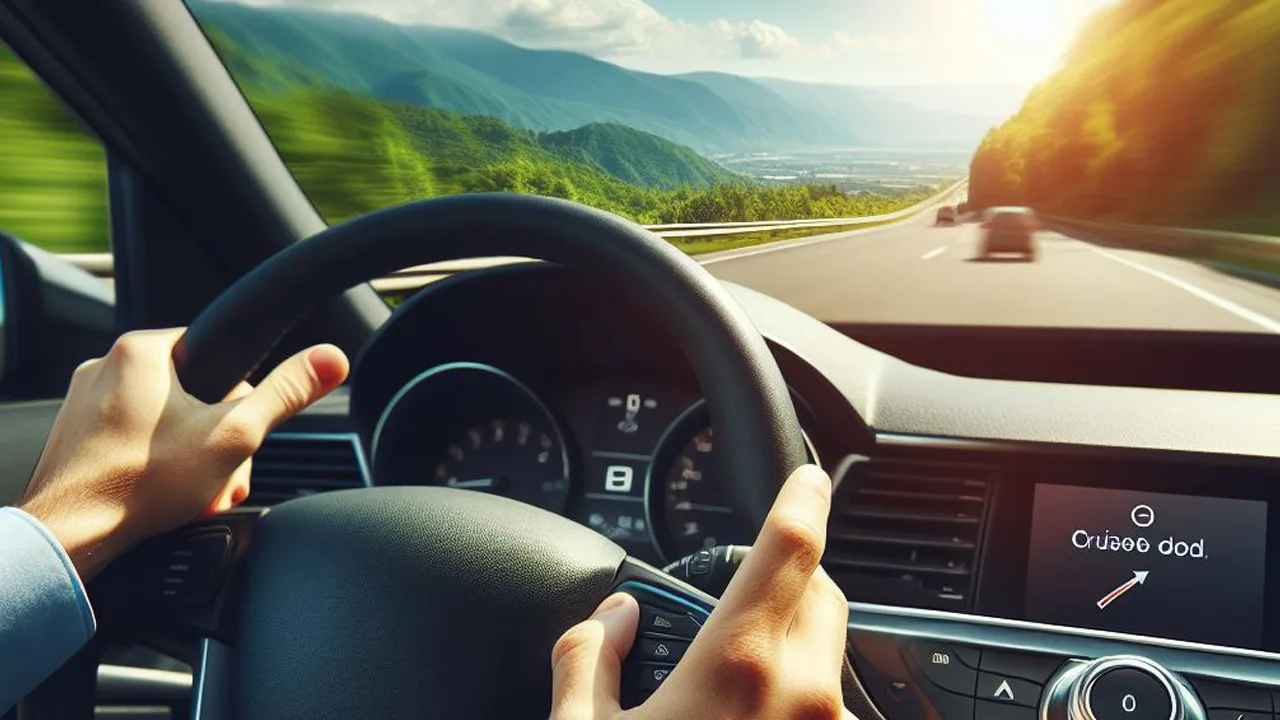
Cruise Control in Cars: Advantages and Disadvantages
Cruise control is a system that enables drivers to maintain a steady speed without constant pedal use. But what exactly is cruise control, and how does it work? In this article, a detailed examination of cruise control will be presented. The types of cruise control and their advantages and disadvantages will be explored, with examples provided to illustrate their effectiveness.
What is cruise control?
Cruise control is a driver assistance system that allows drivers to set a desired speed, which the vehicle will maintain without constant pedal input. This feature is helpful for long road trips, as it reduces driver efforts and improves fuel efficiency. Cruise control systems use a combination of sensors, software, and actuators to regulate the vehicle’s speed, ensuring a smooth and comfortable driving experience.
Types of Cruise Control:
- Traditional Cruise Control: This basic system uses a simple electronic control unit to regulate the throttle.
- Adaptive Cruise Control (ACC): This advanced system uses radar, lidar, or cameras to detect the distance and speed of surrounding vehicles, adjusting the speed accordingly.
- Radar Cruise Control: This system uses radar sensors to detect obstacles and adjust the speed.
- Laser Cruise Control: This system uses laser sensors to detect obstacles and adjust the speed.
- Dynamic Cruise Control: This system adjusts the speed based on road conditions, traffic, and other factors.
Advantages of Cruise Control:
- Reduced Driver Tiredness: Cruise control lightens the load for drivers on long journeys, letting them unwind and lowering the chances of getting tired behind the wheel.
- Improved Fuel Efficiency: By keeping a steady speed, cruise control helps save fuel, which means more money in your pocket and fewer emissions polluting the air.
- Increased Safety: Cruise control aids in maintaining a safe speed, reducing the risk of speed tickets and accidents, and making the roads safer for everyone.
- Convenience: Cruise control is a lifesaver in heavy traffic or stop-and-go situations, allowing drivers to pay attention to other important things.
- Reduced Wear and Tear: By avoiding constant acceleration and braking, cruise control helps to keep the engine, transmission, and brakes in better shape for longer.
Disadvantages of Cruise Control:
- Distraction: Overreliance on cruise control can lead to driver distraction, as drivers may become too comfortable and disengage from the driving process.
- Lack of Control: Cruise contro l can make drivers feel less in control, particularly in situations requiring quick acceleration or braking.
- Inadequate for Complex Driving: Cruise control is not suitable for complex driving situations, such as navigating curves, construction zones, or pedestrian-heavy areas.
- Dependence on Technology: Cruise control relies on electronic systems, which can malfunction or fail, leaving drivers unprepared.
- Complacency: Overuse of cruise control can lead to complacency, causing drivers to become too relaxed and less attentive.
Examples of successful implementation:
- Adaptive Cruise Control in the Toyota Camry : This system uses radar and cameras to detect obstacles and adjust the speed, providing a smooth and safe driving experience.
- Dynamic Cruise Control in the BMW 5 Series: This system adjusts the speed based on road conditions, traffic, and other factors, providing a comfortable and efficient driving experience.
- Laser Cruise Control in the Audi A4: This system uses laser sensors to detect obstacles and adjust the speed, providing a precise and safe driving experience.
Conclusion:
Cruise control is a valuable feature in modern cars, offering benefits like reduced driver fatigue and improved fuel efficiency. However, it’s essential to be aware of its limitations and potential drawbacks, such as driver distraction and reduced control. By understanding the various types of cruise control and how they work, drivers can make the most of their advantages while reducing their disadvantages. As driver assistance systems become more popular, cruise control will continue to be an important feature in the automotive industry.
Leave a comment Cancel reply
Save my name, email, and website in this browser for the next time I comment.

- Upcoming Cars
- Popular Cars
- Latest Cars
- Electric Cars
- Latest News
- Press Release
- Compare Cars
- Variant Explained
- Review Videos
- Compare Videos
- Variants Explained Videos
- More Videos
- Auto Expo Videos
- V3Cars YouTube Channel
- Expert Review
- Comparison Review
- Features Explained
- User Review
- Car Loan EMI Calculator
- Fuel Cost Calculator
- Buy / Renew Car Insurance
- Fuel Price in India
- Apply for Car Loan
- Mileage Calculator
- Car On-Road Price
- Sell Used Car
Login to V3Cars
Sign Up to V3Cars
This is necessary to personalise results for you
OTP has been sent to
Select City
Cruise Control - Feature, Pros & Cons, Working Explained
- 27 January 2024
- By Nikil Jonathan
In this Feature Explained article, we’ll present the most detailed analysis of the cruise control feature in your car. We’ll list out the pros and cons of cruise control, explain how it works, provide the typical cost of getting the cruise control feature from the aftermarket and its repair and replacement costs. Based on this analysis, you can decide the importance of this feature for your car ownership experience.
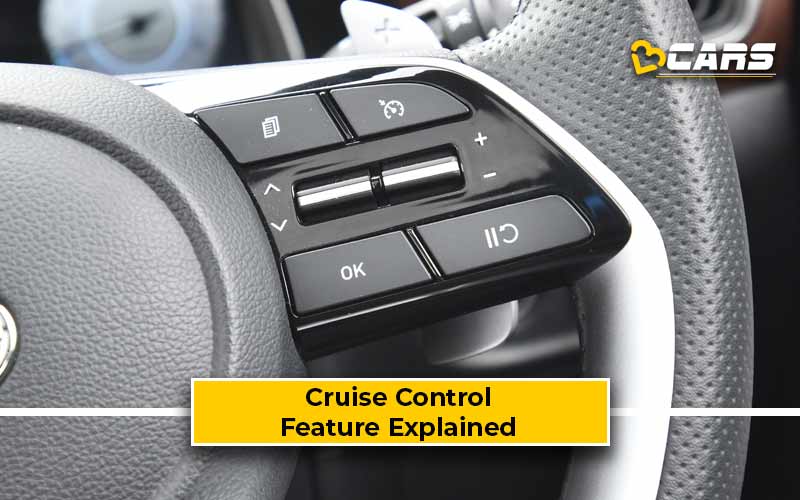
We have also included a list of affordable cars in India with cruise control to help you make informed purchasing decisions.
What Are The Pros And Cons Of Cruise Control?
Cruise control, the automotive equivalent of a rice cooker, can be a blessing on long highway drives. But like any powerful tool, it comes with its own set of challenges. Let's dive into the pros and cons of using cruise control to help you decide if it's the right fit for your driving style.
The pros or advantages of cruise control are:
- Effortless Speed: Say goodbye to constant foot adjustments! Cruise control maintains your desired speed, reducing fatigue and leg strain on long journeys. Think of it as an extended chai break for your feet.
- Fuel Efficiency Friend: Consistent speed translates to optimal fuel economy. Cruise control minimises unnecessary acceleration and braking, leading to potentially improved mileage.
- Highway Hero: On open roads with steady traffic flow, cruise control takes the edge off long drives. It can help you avoid unintentional speeding and keeps you relaxed, making the journey less stressful.
The cons or disadvantages of cruise control are:
- Drowsiness Danger: The hypnotic hum of constant speed can lull even the most alert driver into a false sense of security. Remember, cruise control doesn't replace the need for active engagement and vigilance.
- Road Reality Check: Cruise control isn't a one-size-fits-all solution. It struggles on winding roads, highways with varying speed limits, or unpredictable conditions. Be prepared to disengage quickly when the road throws you a curveball.
- Distraction Magnet: With your foot off the throttle, it's tempting to multitask or zone out. Remember, you're still the captain of the ship! Stay focused on the road and keep your eyes peeled for potential hazards.
Remember: Cruise control is a tool, not a magic spell. Use it responsibly, stay alert, and be prepared to take the wheel when needed.
What Is Cruise Control?
Forget aching legs and a leaden foot! Cruise control is your saviour on long highway journeys, taking over the tedious job of maintaining speed and letting you relax behind the wheel. Here's how to turn this helpful feature into your highway driving ally:
1. Autopilot Engaged: Ditch the constant pedalling. Cruise control lets you set a desired speed, then handles the throttle input, keeping you cruising effortlessly.
2. Safety First: Cruise control isn't autopilot! Cruise control disengages when you tap the brake, ensuring you're always in control. Just remember to manually reactivate it if you want to pick up the pace again.
3. Fine-Tuning Your Cruise: Feeling a little fast or slow? The "+" and "-" buttons are your speed adjustment tools. Need a quick burst to pass? Simply press the accelerator, and cruise control temporarily suspends itself.
4. Weather Wise: While cruise control is perfect for smooth highways, remember it's not your all-weather companion. Heavy rain, low visibility, or unpredictable conditions are best tackled with good old-fashioned manual driving.
5. Know Your Controls: Before hitting the road, familiarise yourself with your car's specific cruise control buttons. Consult your owner's manual to avoid fumbling while driving.
Cruise control isn't just for long hauls anymore. It's your highway driving hero, reducing fatigue, improving fuel efficiency, and letting you enjoy the journey.
How Does Cruise Control Work?
Modern cars that ply our roads today have drive-by-wire accelerators. This means that our inputs on the accelerator pedal only provide an electrical signal to the car's on-board computers. These clever conductors then interpret your signal, determining the ideal fuel-air mixture to reach your desired speed.
Now, enter cruise control. In a car equipped with this feature, the computers store this "desired speed" as their baseline. They continuously monitor your actual speed using sensors on the wheels. Any deviation up or down triggers a micro-adjustment in the fuel-air mixture, gently nudging the car back to accelerate or decelerate as required.
How Expensive Is It To Repair Or Replace Cruise Control?
The cruise control feature does not typically fail as this is a software-based feature. At best, the only costs associated with maintaining the cruise control feature in your car is if you have somehow managed to break the cruise control stalk or the buttons on the steering wheel that lets you activate this feature. In such instances, you will need to replace the switchgear, which could cost you up to Rs. 15,000 - Rs. 20,000.
Ultimately, the cost of repairing or replacing cruise control can vary widely depending on several factors, including:
- The extent of the problem: Is it a minor issue like a faulty switch or a major malfunction of the control module? More complex repairs will naturally be more expensive.
- Your car's make and model: Different car models have different cruise control systems and parts, with some being more costly than others.
- Labour costs: The location and rates of the repair shop you choose will affect the labour cost involved.
- Whether you choose original parts or aftermarket replacements: Generally, original parts are more expensive than aftermarket options, but they may also be of higher quality and offer better compatibility.
Here are some tips for minimising the cost:
- Get a diagnosis: Before committing to any repairs, have a qualified mechanic diagnose the problem to determine the exact cause and the associated cost.
- Shop around: Compare prices from different repair shops to find the best deal.
- Consider aftermarket parts: For minor repairs, using high-quality aftermarket parts can be a more affordable option.
- Check your warranty: Some car warranties may cover cruise control repairs or replacements.
What Is The Cost Of Aftermarket Cruise Control?
Adding aftermarket cruise control might seem tempting, but consider the pitfalls before installing an aftermarket kit. Here's why factory-fitted cruise control is the smoother and safer route:
1. Installation: Installing aftermarket cruise control, especially in cars without existing variants featuring it, can be a technical challenge. Incompatible parts, complex wiring, and modifications to the steering wheel or steering column can lead to frustration and potential malfunctions.
2. Safety First, Always: Cruise control manages your car's speed, making its performance critical. Opting for an aftermarket solution introduces potential risks as compatibility and quality might not match manufacturer standards, jeopardising your safety and vehicle stability.
3. Warranty Woes: Installing aftermarket cruise control often voids your car's manufacturer warranty. That means any issues arising from the add-on become your responsibility, potentially leading to costly repairs.
4. Factory Finesse: Choosing a car with factory-installed cruise control offers peace of mind. These systems are seamlessly integrated with your car's electronics, ensuring optimal performance, compatibility, and most importantly, safety.
How Easy Or Complex Is It To Install Cruise Control?
The cruise control feature comes fitted from the factory. It is nearly impossible to add this feature once you have bought a car that does not have cruise control. However, if you have broken the controls to this feature, replacing the cruise control stalks or the steering wheel switchgear could take between 3-5 hours depending on the proficiency of the mechanic working on your car. We recommend carrying out such repairs at authorised service centres only.
What Are Some Affordable Cars In India With Cruise Control?
Here are the cars and their variants priced under Rs. 10.0 lakh that offer cruise control in India:
- Hyundai Grand i10 Nios Sportz
- Tata Punch Accomplished
- Hyundai Aura SX
- Tata Altroz XT
- Hyundai Exter SX
- Maruti Suzuki Swift ZXI Plus
- Hyundai i20 Sportz
- Nissan Magnite XV Premium
- Honda Amaze VX
- Maruti Suzuki Dzire SXI
- Maruti Suzuki Baleno Alpha
- Toyota Glanza V
- Maruti Suzuki Ciaz Delta
- Hyundai i20 N Line N6
- Renault Kiger RXZ
Note : Check your car’s fuel cost with Fuel Cost Calculator in India
Verdict - Should I Get Cruise Control From The Aftermarket?
The cruise control feature is nearly impossible to install from the aftermarket if none of the variants of your car have this feature. Even if you find a workshop willing to take up this job, be warned that this will be installed using aftermarket kits that aren’t tested or calibrated by your car’s manufacturer. Hence, we recommend spending a bit more and buying the variant that offers this feature. Cruise control is especially useful for car owners who frequently drive on the highways. However, if you mostly drive within the city, then you can skip this feature altogether.
Note: Check your Car EMI with our - Car Loan EMI Calculator
ABOUT THE AUTHOR

Nikil Jonathan
Nikil's a huge fan of classic cars, especially Italian beauties such as the Alfa Romeo Giulia Sprint and the Iso Grifo. His love for cars and bikes originated when he first laid his eyes on a poster of the Ferrari F40 and the MV Agusta F4 when he was just a child. He also loves all things analogue, especially vintage cameras and turntables.
Maruti brezza zdi cruise installation
Balino 2016 automatic Give me price cruse control
Leave a Reply
Post Comment
Get updates and price details of on launch:
Find a local trusted garage
Search by garage name
Cruise Control: The Pros and Cons
You may not have had much opportunity to drive longer distances over the last year, but as restrictions are looking likely to ease, you may be starting to think about long overdue trips to see family, for work or for leisure.
Automotive technology seems to improve every day, with intelligent driving systems, electric and hybrid vehicles on the road, and even driverless cars soon to be a reality. Most of this technology has two motivations (other than making money for the manufacturer): to improve the driver’s comfort, and to improve road users’ safety. But can being too comfortable be dangerous?
In a nutshell, cruise control allows you to keep your vehicle at a set speed without having to use your accelerator or brake. You still steer and, of course, you can still brake should you need to, but as long as your feet remain off the pedals, your speed will remain the same. There’s no doubt that cruise control can be a knee saver on a long motorway journey. But before you reach for the cruise control, we look at the pros and cons of handing your control over to a piece of metal – albeit a very clever one.
The pros of cruise control:
- Easier on the joints on long journeys.
- Allows you to maintain a steady, legal speed so you are less likely to accidentally edge over the limit.
- Increased fuel efficiency thanks to the consistent speed.
The cons of using cruise control:
- Speed control is great – when used in the right situation. However, it is not intuitive – the vehicle’s speed will remain the same no matter what, unless the driver hits the brake or the accelerator. This means that if you take a corner too fast as a result of cruise control, the delay in braking can be a potential risk to safety. Likewise, if you skid or lose control, your vehicle will remain at the set speed, whereas a person would be more likely to take their foot off the accelerator.
- Is it possible that cruise control is too relaxing? If you are tired or relaxed and there is no need to focus on your speed, it can be easy to become distracted or – in the worst case - fall asleep at the wheel.
- Even if you stay relatively alert at the wheel, with one less thing to focus on, it can lead to a general lack of attention to the road – as a result, this can lead to delayed braking or failure to react swiftly in the event of an emergency.
The verdict:
If you have ever hit the motorway only to see the sat nav say “stay on road for another 130 miles” then you will probably love cruise control. Dodge the risk of getting a speeding ticket, and save your leg at the same time. Like many technological advances, there is a time and a place for cruise control: busy or twisty roads? No. Steady motorway or carriageway journeys? Put the radio on, stay alert, and enjoy the journey.
For more advice, join our community of trusted local garages on Twitter or Facebook .
- Cruise Control
- Road Safety
Was this useful?
- Share on Facebook
- Share on Twitter

- Entertainment
- Submit Your Story
Explained: The different kinds of cruise control and how they work
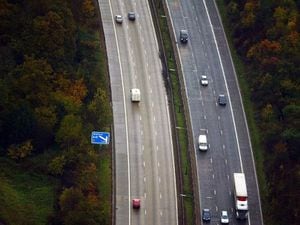
Hands-free driving may be a relatively new innovation – but foot-free driving has been around for decades. In fact, the first cruise control systems were installed over 60 years ago – and in many ways they operate identically to the systems found today.
But what exactly is cruise control? Put simply, it’s an automatic system which keeps your car at a constant speed with as little variation as possible. The inventor, Ralph Teetor, was said to have come up with the idea after a frustrating journey with his lawyer, who sped up and slowed down as he talked.
How do you use cruise control?
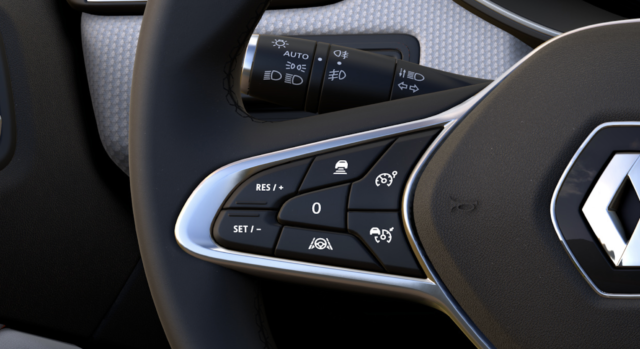
Cruise control is offered as standard equipment or at least as an optional extra on nearly every new car sold in the UK – though you may need to look a bit harder for it if buying an older vehicle. Basic systems are usually operated by a control either on the steering wheel or a steering column stalk.
Cruise control consists of an up/down (or +/-) control, as well as a ‘Set’ button, a ‘Recall’ button and sometimes an on/off button. The driver brings the car up to their desired speed, and if the system is switched on, pressing ‘Set’ will store that speed in the car’s memory.
The vehicle will then take control of the accelerator, keeping the car at the desired speed for as long the driver wants. Fine-tuning of the speed can be achieved with the +/- controls, and the target speed is often shown on a dashboard display.
The system is switched off in two ways – either with external input, such as the driver pressing the throttle or brake, or by using the on/off switch. At this point, the desired speed is still usually stored in the car’s memory, and that’s what the ‘Recall’ button is for – allowing the driver to return to their previous speed after passing an obstruction, junction or traffic.
What are the other kinds?
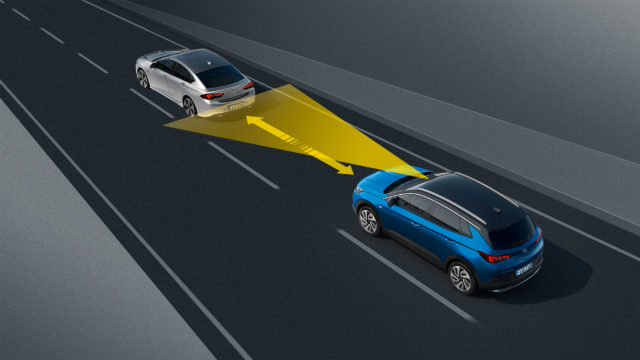
There’s not really much you can innovate on cruise control, but car manufacturers have managed to do it – and come out with adaptive cruise control and advanced adaptive cruise control.
Adaptive cruise control adds a scanner to the front of the car, usually a camera, radar, or laser array – or some combination of the three. This continuously scans the road ahead for traffic and is able to detect when there’s a car in front.
The system then alters your car’s speed so that instead of closing the gap to a slower-moving car, it will follow it at a set distance – controllable by the driver. The car will continue to match the speed of the car in front until it changes lane, exits the road or the driver overtakes.
Advanced adaptive cruise control adds an extra layer to this, as it’s capable of altering the cruise control’s speed limit to match the speed limit of the road it’s driving on – ensuring that the driver is never speeding.
Adaptive cruise control is usually paired with a form of autonomous emergency braking, and usually with lane-keeping assist, too. The most sophisticated systems will work at any speed – from following cars at high speeds on the motorway to crawling autonomously at the back of a queue of stop-start traffic. These systems are usually paired with an automatic gearbox, to prevent over- or under-revving by an inattentive driver. Cruise control in manual cars is usually disengaged when the clutch or gears are operated.
What are the advantages and disadvantages?
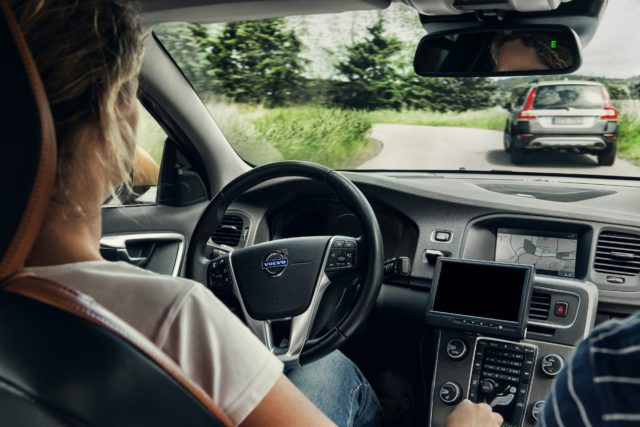
Cruise control has several advantages, chief among which is fatigue reduction. Allowing drivers to take their minds off keeping a constant speed allows them to focus more on steering and interacting with other traffic, as well as allowing them to stretch their legs and reduce muscle aches.
Advanced adaptive cruise control can prevent accidents thanks to its sensor array knowing where other vehicles are, and systems capable of reading speed limits can prevent drivers violating them and risking a ticket. It can also improve fuel efficiency.
However, it can be dangerous. Sophisticated systems, especially those paired with lane-keeping assistance tech, can encourage drivers to pay less attention when driving, increasing the risk of a collision.
Older systems were also very dangerous in the rain, on icy roads or on loose surfaces. That’s because the loss of traction in a wheel could lead the car to speed up rather than slow down, resulting in a total loss of control.

Bridgnorth star of film and TV heads back to her home town am dram Bridgnorth | 23 hours ago
Town centre shop to get rebrand in bid to cause less confusion and entice more customers Plus Business | 23 hours ago
Thousands of Tesco workers to split £30m windfall UK News | 13 hours ago
Teenager set to open barber shop in Shropshire town that hasn't had one for more than 10 years Much Wenlock | 23 hours ago
'We apologised and refunded money': Council bailiffs took money that wasn't owed from Telford church Telford | 23 hours ago
What is Cruise Control in cars?
Written by: CarBike Tech
Published on: April 2, 2014

How does Cruise Control Work?
The Cruise Control is a system capable of automatically maintaining the desired speed (i.e., speed set by the driver) without pressing the accelerator pedal. This system is beneficial while driving at a constant speed as it significantly reduces driver fatigue .
Components:
The system uses many components for its operation. They are:
- Steering Wheel Controls
- Vehicle speed sensor
- Clutch pedal switch
- Brake pedal switch
- Throttle position sensor
- Vacuum valve control
- Vacuum actuator

Working of Cruise Control:
After attaining the desired speed, the driver can activate this system with the help of steering-mounted controls. Usually, manufacturers provide buttons named ON, OFF, SET/ACCL. However, they vary broadly from manufacturer to manufacturer. For example, the ON and OFF buttons are for activation and deactivation, respectively, while the SET/ACCL button helps set the required speed.

But, the vehicle must attain that speed before setting. Thus, the system comes to know the vehicle’s speed from the speed of the driveshaft. Alternatively, it takes the input from the wheel speed sensors and sets the throttle fixed at that location. In addition, the manufacturers mostly prefer vacuum-operated actuator mechanisms to hold the throttle in position.
Almost all cruise control systems get disabled as soon as the driver touches either the brake or the clutch pedal. Manufacturers program these systems in such a way that they turn ‘OFF’ upon human intervention.
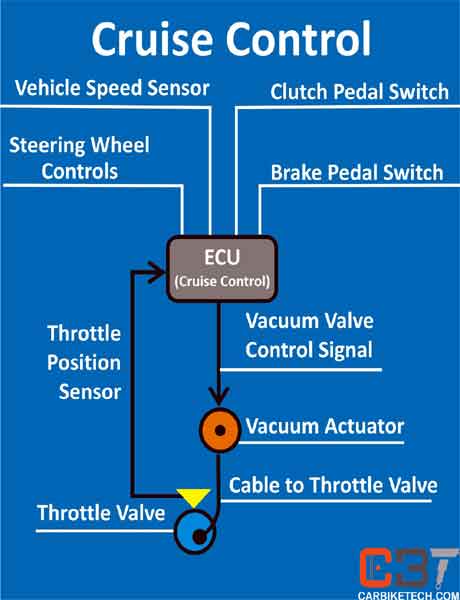
Advantages:
- This system helps improve driving comfort on long journeys as there is no need to press the accelerator pedal.
- It reduces driving fatigue to a great extent.
- It improves the fuel economy of the vehicle significantly.
Disadvantages:
- This system is not helpful in heavy traffic conditions with varying speeds.
- Its inability to recognize the road surface may lead to skidding on wet or icy surfaces.
Please find additional information on the subject here .
Watch Cruise Control System In Action Here:
Read On: What Is Active Trace Control and How Does It Work?>>
About CarBike Tech
How does ABS work?
What is ebd in cars.
Most drivers don't understand limitations of car safety systems, AAA finds

Most drivers don't understand the limitations of advanced safety technology installed on new vehicles, according to a new study by AAA Foundation for Traffic Safety.
The study indicates that drivers overestimate the capabilities of features such as blind-spot monitoring systems, automatic emergency braking and adaptive cruise control.
"A substantial proportion of respondents demonstrated what we believe was a concerning lack of awareness of some of the key limitations of the technologies," said Brian Tefft, senior researcher for the AAA Foundation.
The findings raise questions about whether Americans are ready to adapt to partially self-driving vehicles, which typically require drivers to remain alert and ready to take over the steering wheel if the car can't handle the conditions it encounters.
Problem spots flagged by AAA:
• Blind-spot monitoring: Nearly 80 percent of drivers don't understand the limitations or thought that the system had greater capability to detect fast-approaching vehicles, bicycles and pedestrians. Relying too much on blind-spot monitoring, about 25 percent don't look for oncoming vehicles when they change lanes.
• Forward-collision warning and automatic emergency braking: Many drivers confuse the two. One is a warning system, while the other takes action. More than 40 percent of drivers don't know these limitations.
• Adaptive cruise control: About 29 percent of drivers who use this system, which accelerates and brakes on its own, are sometimes comfortable "engaging in other activities" while the system is activated, according to the study.
To be sure, the researchers emphasized that advanced driver assistance systems are generally helpful. Such technologies can prevent about 40 percent of crashes and 30 percent of crash deaths, according to federal estimates.
Talking Tech: From compact speakers to selfie sticks: Best gadgets you can find at the dollar store
Talking Tech: With Sirius behind it, can Pandora now stage a comeback?
Talking Tech: T-Mobile's MetroPCS changes name and adds unlimited lure: Amazon Prime and Google One
The problem is that technology backfires when people don't understand how it works.
"I think there's a general assumption among members of the public that technologies in vehicles today will do things for us," said Jake Nelson, director of traffic safety advocacy and research for AAA. "These technologies are not meant to replace us behind the wheel. They’re meant to help us out."
Nelson said that it's important for dealers, automakers and rental-car companies to educate drivers, at the time they take delivery of their vehicle, on how these systems work.
And "we shouldn't be marketing them in a way that could potentially mislead folks," Nelson added.
Follow USA TODAY reporter Nathan Bomey on Twitter @ NathanBomey .
- Firm Overview
- Mike Bottaro ESQ.
- Work for Us
- Testimonials
- Car Accident
- Truck Accident
- Motorcycle Accident
- Bicycle Accident
- Slip and Fall
- Wrongful Death
- See All Cases We Handle

The Pros and Cons to Cruise Control
The cruise control feature in vehicles is fairly common and beloved by many road-trippers. Although there are many pros to cruise control, there are also many cons that accompany it.
Benefits of Cruise Control
The number one benefit to cruise control is controlling speed. According to the National Highway Traffic Safety Administration (NHTSA) the estimated total economic cost of speeding is around $40 billion a year, or $1,281 per second. Since cruise control allows drivers to keep their vehicle at a constant speed, there is less risk of the driver accelerating and speeding past other drivers. Additionally , cruise control limits the amount of fuel your engine uses and reduces gas-wasting acceleration and deceleration. Therefore, cruise control helps improve your fuel economy and helps save you money on gas. Esurance noted that by setting your cruise control to 60 mph you would improve your fuel efficiency by an average of 17.2 percent.
Disadvantages of Cruise Control
Although cruise control can make a long highway trip more enjoyable, it can also reduce your reaction time while driving and impair your ability to safely change lanes. It has been reported that cruise control increases the risk of drowsy driving and leads to distracted driving accidents. Drivers have reported that they are more likely to get distracted and zone out while using cruise control since they do not have to focus on their speed to make sure they are not speeding. Additionally , it has been reported that prolonged use of cruise control leads to later use of the vehicle’s brakes. Therefore, a driver’s reaction time is decreased and this can lead to serious motor vehicle accidents and subsequent injuries.
When You Should Not Use Cruise Control
Although cruise control is often helpful on longer drives, there are times when cruise control is not a driver’s best option. For example , when you are driving on winding roads, in heavy traffic, or when you approach a bridge or an overpass. Additionally, Esurance notes that you should never utilize your cruise control while driving on icy or wet roads or during downpours, hailstorms, or snowstorms. Furthermore , you should never use cruise control later at night or when you are tired.
Contact Us Today
Our team at the Bottaro Law Firm, LLC is ready to fight for your rights and get the results you deserve! If you or a loved one has been involved in an accident and has sustained injuries do not hesitate to contact us for a free consultation . Call or text us at 401-777-7777 or fill out our free online form.
Office Hours

Cars and motors online
Cruise control: advantages and disadvantages.
- By chritina
- 21 April 2021
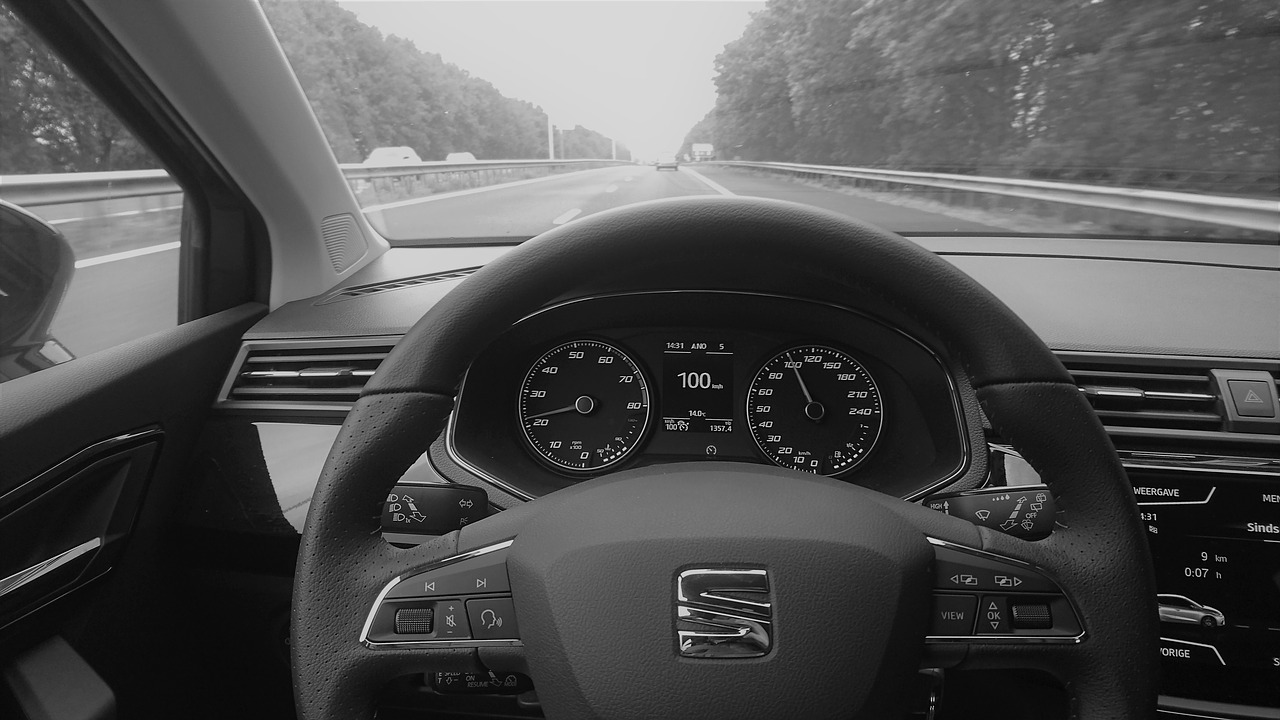
More and more cars are equipped with a speed limiter. This device is helpful on long journeys, but it may cause the driver to become less attentive. How does cruise control work? What are its advantages and disadvantages?
1. What is adaptive cruise control?
2. why install a speed limiter on a car, 3. when to use cruise control, 4. adaptive cruise control and car insurance.
Adaptive cruise control is a type of autopilot designed to improve your comfort and safety while driving. It is used to maintain a constant speed on fast lanes and is much more restrictive than a simple speed limiter.
You can tell your car to maintain a constant speed until you brake by pressing the cruise control button. The vehicle accelerates uphill, decelerates downhill, and becomes nearly self-driving; the driver’s only responsibility is the steering wheel.
Cruise control and speed limiter are often combined into one device.
– The speed limiter makes it possible to program a maximum speed that you should not exceed. This system can thus avoid the loss of points and the associated fine in case of speeding.
– The cruise control brings an additional aspect by regulating the speed along the route. When going uphill, the regulator will accelerate the engine to compensate and, on the contrary, will slow down when going downhill. It will also reduce fuel consumption and fatigue during a long trip.
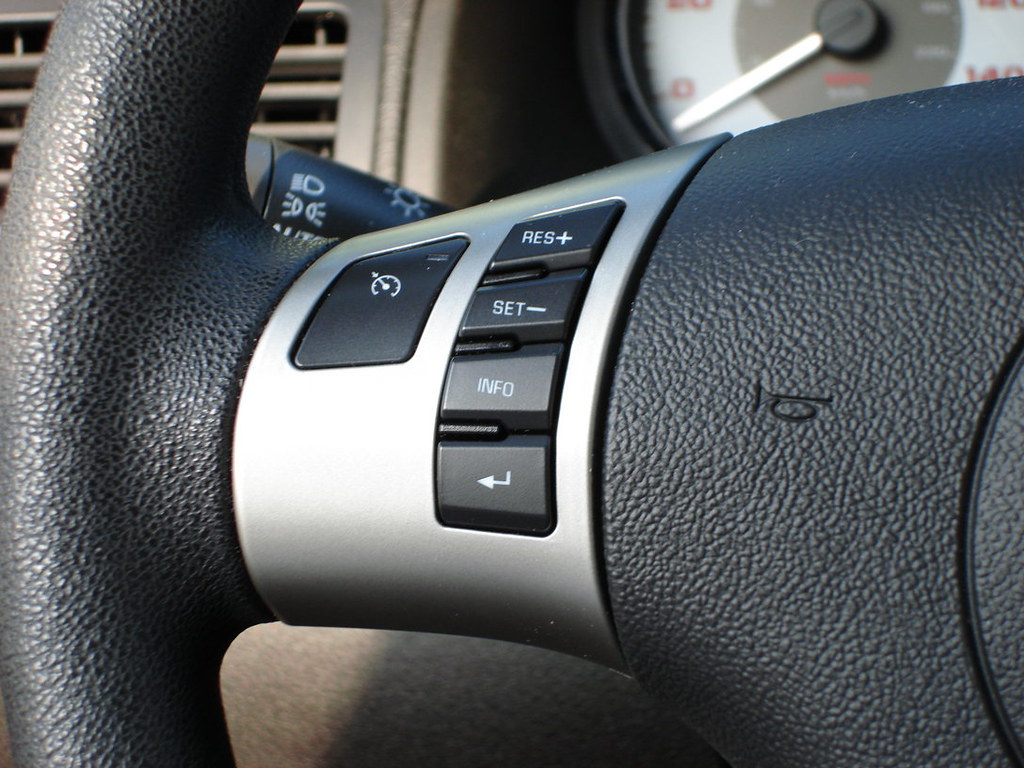
Despite significant progress since the first models, some drivers mistrust these driving aids widely used in the United States and Germany.
Are you using a speed limiter? Take the following precautions:
– Never use your cruise control or speed limiter in built-up areas or on small roads;
– Take control when approaching a tollbooth or any cause for slowing down;
– Once the device is activated, do not fall asleep! Stay alert and in control of your vehicle at all times.
– Your cruise control has locked up; what should you do? This is an exceptional situation. Usually, a quick press of the gas pedal is all it takes to disable the cruise control system. Don’t panic; shift into neutral and apply the brakes. As a last resort, gradually apply the handbrake to keep the car on the track.
– How do you know if your speed limiter has activated properly? Take a look at your dashboard: the speed limiter symbol should be displayed. Press the gas pedal to deactivate it: the symbol will disappear.
Good to know: you can only use this system on long, unobstructed trips. It is perfect for driving to your vacation destination but is ineffective in city centers where traffic signs are particularly dense.
As far as car insurance is concerned, the presence of an adaptive cruise control does not affect your potential liability in case of an accident.
Even if a faulty speed limiter causes a collision, only the driver will be held responsible. In this case, you are free to take legal action against the manufacturer for hidden defects.
For cars that do not have these speed control devices, some specialized stores offer kits. However, check that they are approved, which is not always the case with certain parallel imports that bypass the traditional distribution networks.
How did you find this post? Remember to leave your comment and share.
You can read more here:
– Unforeseen Issues When You Are Driving Above the Speed Limit ;
– What Does Double-Clutching Mean?
– How Does Car Camber Work?
Leave a Reply Cancel reply
Your email address will not be published. Required fields are marked *

What Is Cruise Control and How To Use It ?
Cruise control, once a luxury exclusive to high-end vehicles, has become a standard feature in modern cars. This system, designed for ease during long drives, offers drivers the ability to maintain a constant speed without continuous accelerator input. Let’s delve into how it works and how to effectively utilize this advantageous feature.
What is Cruise Control ?
Cruise control is a sophisticated feature within advanced driver assistance systems (ADAS) that enhances comfort and safety while driving. It’s a technological innovation in cars aimed at providing a more convenient and secure driving experience. This system is designed to uphold a consistent speed without requiring constant manual input from the driver.
Modern cars often come equipped with Adaptive Cruise Control (ACC), an enhanced version of traditional cruise control. ACC utilizes radar sensors to sustain a preset speed while automatically adjusting it to maintain a safe distance from the vehicle in front.
When the vehicle ahead reduces its speed, your car will also slow down, ensuring a safe and consistent gap between the two vehicles. This feature effectively assists in maintaining a safe driving distance, enhancing overall safety on the road.
How it Works ?
Adaptive Cruise Control (ACC) relies on two key sensors: a radar sensor and a speed sensor. The radar sensor gauges the distance between your car and the vehicle in front, while the speed sensor manages your car’s acceleration and deceleration. By leveraging data from these sensors, ACC autonomously regulates your speed, ensuring it maintains the pre-set distance from the leading vehicle.

How to Use it ?
Basic operation involves using designated buttons typically located on the steering wheel. The “ON/OFF” button activates cruise control, while “Res +,” “Set -,” and “Cancel” buttons adjust speed, set desired speed, and deactivate the system, respectively.
Benefits of Cruise Control
Here are the benefits of cruise control:
- Reduced Fatigue: Cruise control lessens driver fatigue during long journeys by maintaining a consistent speed, eliminating the need for continuous manual speed adjustments.
- Improved Fuel Efficiency: By maintaining a steady speed, cruise control can enhance fuel efficiency by preventing unnecessary speed fluctuations.
- Convenience: Offering convenience and comfort, cruise control allows drivers to relax a bit more during their travels, especially on extended trips.
How to Activate Cruise Control ?
Activating cruise control varies slightly from car to car, but the basic steps remain consistent across most vehicles. Here’s a general guide on how to activate cruise control:
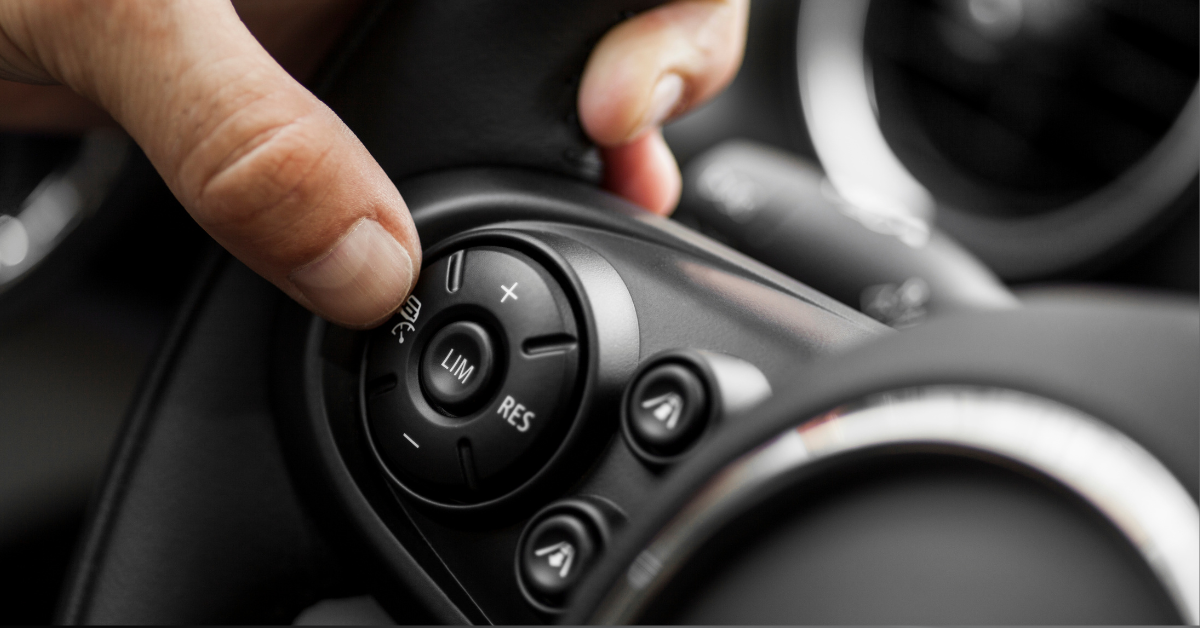
- Locate the Controls: The cruise control buttons are typically positioned on the steering wheel or a stalk near the steering column. Look for buttons labeled ON/OFF, RES+, SET-, and CANCEL.
- Turn ON the System: Start by driving at your desired speed on a relatively clear road. Press the ON/OFF button to activate the cruise control. You’ll notice a cruise control indicator light illuminating on the dashboard, indicating that the system is ready to set a speed.
- Set the Speed: Once the system is ON, use the accelerator to reach your desired speed. Then, press the SET- or SET+ button (depending on the car) to set this speed as the target for cruise control. A ‘Cruise Set’ or similar icon will appear on the dashboard, signifying that the speed is locked in.
- Adjust Speed Incrementally: To increase the set speed, press the RES+ button in small increments (usually 1 mph each press). Conversely, use the SET- button to decrease the speed gradually. Each press adjusts the speed by 1 mph.
How to Deactivate Cruise Control ?
Deactivating cruise control is a straightforward process, and there are a few common methods to disengage it:
- Cancel Button: Many vehicles come equipped with a dedicated cancel button for cruise control. Pressing this button will instantly disable the cruise control system.
- Brake Pedal: Gently tapping the brake pedal will deactivate cruise control. When you apply the brakes, the system automatically disengages, allowing you to slow down or stop as needed.
- Clutch (Manual Cars): In manual transmission cars, pressing the clutch pedal can also deactivate cruise control. However, this feature might vary depending on the vehicle make and model.
Regardless of the method used, engaging the brake pedal is a universal way to cancel cruise control in most cars.
Advanced Pro Tips to Use Cruise Control:
Overtaking while in Cruise Control:
If you need to accelerate to overtake another vehicle while in cruise control, gently apply pressure to the accelerator. For instance, if you wish to surpass a car, increasing your speed to 75 mph, simply press the accelerator. Once you’ve reached your desired speed, ease off the accelerator, allowing the car to decelerate naturally. Once it returns to the preset cruising speed of 70 mph, the cruise control will resume automatically.
Slowing Down in Cruise Control:
To slow down while using cruise control, most people tend to apply the brake, which disengages the system. Once the cruise control is turned off, you can hit the resume button to return to the previously set speed. Alternatively, if there’s a need to adjust your speed due to a speed limit change or other circumstances, press the set button instead of resume. This action will maintain the speed you’ve chosen. Additionally, if a slow-moving vehicle obstructs your path and you can’t pass, pressing the cancel button will halt the cruise control, allowing you to regain manual control of the speed.
Limitations of Adaptive Cruise Control
Here are some limitations of cruise control systems:
1. Curving Roads: Cruise control, especially Adaptive Cruise Control (ACC), primarily focuses on the forward view to detect vehicles. On curving roads, this system may encounter difficulty in accurately identifying traffic due to its limited frontward field of vision.

2. Hilly Roads: Similar to curving roads, ACC might face challenges on hilly terrain. Since it maintains a straight-ahead view, it may struggle to perceive vehicles up or down hills or around bends, potentially leading to incorrect responses.

3. Merging Traffic: ACC systems detect vehicles directly in front of your car, which might not cover merging or adjacent traffic. Vehicles merging into or out of your lane might not be within the system’s field of view, leading to undetected vehicles.
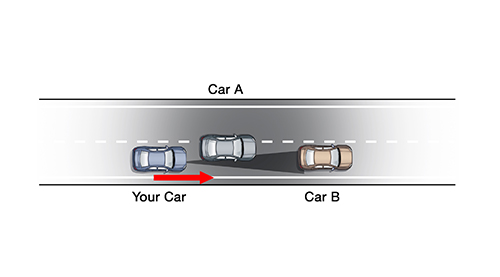
4. Slow and Heavy Traffic: While cruise control assists in regulating speed in traffic, it may encounter difficulties in heavy traffic situations. The system’s ability to detect, judge distance, and maintain appropriate speed might be challenged by abrupt lane changes or frequent braking. In slow traffic conditions, many systems disengage below a certain speed.
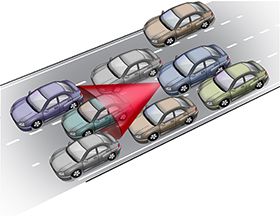
5. Hazardous Weather Conditions: In hazardous weather conditions, such as heavy rain, fog, or snowstorms, the sensors and radar systems used in cruise control may face limitations in detecting vehicles in front of your car. Reduced visibility due to weather elements can impair the sensors’ functionality, potentially affecting the system’s ability to accurately detect and respond.
When to Use Cruise Control?
Certainly, cruise control proves beneficial in various scenarios:
- Long highway drives : Ideal for maintaining a consistent speed during extended journeys on highways, reducing fatigue and allowing the driver to focus on the road.
- Well-marked lanes : In situations where the lanes are clearly defined, cruise control can aid in maintaining a steady speed without veering off course.
- Fair weather conditions : When the weather is favorable, cruise control can be effectively utilized to sustain a set speed, promoting a more relaxed driving experience.
When Not to Use Cruise Control?
It’s advisable to refrain from using cruise control in the following scenarios:
- Heavy traffic : Avoid engaging cruise control in congested traffic situations where frequent speed adjustments and lane changes are necessary.
- Congested city roads : In urban areas with numerous intersections and frequent stops, it’s best to rely on manual control to navigate traffic.
- Steep or winding terrains : Cruise control may not adapt well to steep inclines or winding roads, requiring more dynamic speed adjustments and control.
- Adverse weather conditions : Avoid using cruise control in hazardous weather like heavy rain, snow, or fog where reduced visibility and slippery roads can impede its functionality.
Good Practices while Using Cruise Control
Some good practices to keep in mind while using cruise control:
- Focus on the road : Even with cruise control engaged, stay attentive and alert, keeping your focus on the road ahead for any potential hazards or changes.
- Ready to take control if necessary : Keep your feet near the pedals, ready to intervene in case of unexpected situations or emergencies.
- Monitor your set speed : Regularly check your set cruising speed to ensure it’s appropriate for the current driving conditions.
- Road conditions : Stay aware of the road conditions, including curves, inclines, or changes in surface, and adjust your speed manually if needed.
- Traffic to ensure safe distance : Continuously monitor the traffic around you, maintaining a safe following distance and adapting your speed accordingly to ensure safety.
Madhurjya Dutta is a seasoned industrial maintenance Engineer with over 10 years of experience in troubleshooting complex machinery and systems. His passion for problem-solving extends beyond his profession, as he is also an enthusiast of day-to-day tech troubleshooting.
He has a keen eye for detail and a systematic approach to diagnosing and resolving issues.
Leave a Reply Cancel reply
Your email address will not be published. Required fields are marked *
Save my name, email, and website in this browser for the next time I comment.
Cruise Control: All you need to know for a relaxed cruise
Cruising on the highway to the beat of your favourite song – isn’t that an experience we all crave every once in a while?
However, manually maintaining the speed of your car with the accelerator pedal becomes tiring and uncomfortable over long distances.
Enter ‘ cruise control ’ – a feature that is becoming increasingly popular in higher-end car variants. Curious to know what exactly this feature does and whether it’s worth having? Read on.
Table of Contents
What is cruise control, how to use cruise control, advantages of cruise control in a car.
- Disadvantages of cruise control in a car
Adaptive cruise control
Adaptive cruise control vs cruise control, faqs about cruise control.
Cruise control is a system that maintains car speeds set by the driver without requiring them to press the accelerator pedal. Moreover, it doesn’t let the car go above or below the set speed unless the driver presses the brake or accelerator pedal.
The function of cruise control is an automatic replication of the way a driver manually controls a vehicle’s speed. Early cruise control systems worked with a cable and an actuator to control the throttle valve.
Today’s modern cruise control systems have replaced the cable with various sensors connected to an ECU (Electronic Control Unit) . When the driver sets a speed, the ECU computes the driver’s input to the throttle and then configures the throttle accordingly. The system invariably maintains the speed set by the driver and adjusts the throttle configuration for the set speed to remain unaltered by the changing road conditions.
Before activating the cruise control in a car, check for adverse weather conditions. Refrain from using cruise control at high speeds during rains as low visibility and unpredictable road conditions make driving unsafe.
Nevertheless, the following steps will help you understand how to use the cruise control system in your car:
- Step 1 – Accelerate the car to the speed you’d like to set. Be mindful: do not cross the speed limit of the road or highway.
- Step 2 – Once the car reaches the desired speed, activate cruise control by pressing its button which is either on or near the steering wheel. Remember to locate the button before deciding to activate cruise control.
- Step 3 – Take your foot off the accelerator pedal as the car doesn’t need your input anymore to maintain a constant speed.
- Step 4 – While driving, keep your eye on the road and be prepared to react to changing road conditions. Be ready to push the brake if you encounter an obstacle.
- Step 5 – If you want to accelerate, you can press the given ‘+’ (plus) button.
- Step 6 – If you want to decelerate, you can press the given ‘-’ (minus) button.
- Step 7 – If you even slightly press the brake pedal, the car should deactivate the cruise control.
The buttons to engage cruise control, accelerate, and decelerate vary from car to car. So, remember to check before getting behind the wheel.
The cruise control feature is meant to minimise drivers’ fatigue while driving long distances, by keeping the car running at a constant speed without any manual input. The driver doesn’t need to keep the accelerator pedal pressed and can let their foot relax. Cruise control is mainly used on highways when it can be engaged for longer durations.
Increases mileage
When a car runs at a constant speed, its engine also operates at constant RPMs (Revolutions per minute). With fewer fluctuations in speed and RPM, fuel consumption is also controlled to a great extent, helping to increase your car’s mileage on long highway journeys.
Helps you drive safely
Drivers usually tend to cross the speed limit on clear, endless highways. With cruise control, you can set your speed below the highway’s speed limit and travel safely.
Effortless control
To increase or decrease the speed of your car, you generally use the accelerator and brake pedal. While on the highway, you may want to adjust the speed to match the road conditions. A cruise control system’s speed can be controlled with buttons on your steering wheel, giving you adaptive control on the road. More expensive cars are also equipped with adaptive cruise control, where this operation is done automatically.
Disadvantages of cruise control in a car
Limitations of indian roads.
Cruise control is a feature best suited to wide, long, smooth, and (most importantly) clear highways. While India has a fantastic network of smooth highways, one may face obstacles such as cattle, dogs, etc. along the way. Moreover, many people disregard the regulations and speed limits and jeopardize highway journeys.
Increases reaction time when you need to be quick
Due to the uncertainty on Indian roads, you never know when you might need to press the brake pedal all of a sudden. If you encounter an emergency while cruise control is activated, it might take you slightly longer to apply the brakes and save yourself from an accident.
It can lead to drowsiness
With activated cruise control, the car can remain at a constant speed for as long as you want. As the cruise control reduces active involvement in driving, your alertness level may drop which eventually leads to drowsiness. We highly recommend disengaging cruise control every 10 to 15 minutes.
A level 1 autonomous driving technology, adaptive cruise control uses radar sensors to evaluate the difference in speed and distance from the car ahead. For instance, if the vehicle ahead of your car slows down or speeds up, with adaptive cruise control your car will reduce its speed or accelerate to maintain the set distance from the preceding vehicle. Adaptive cruise control is usually found in premium cars. However, it has now trickled down to some premium passenger cars such as the Mahindra XUV700, MG Gloster and MG Astor.
Cruise control is a major attraction in variants that come with it, and while it definitely sounds like a dream, it may not be for everyone. So before you decide to get yourself a car with cruise control, understand how it works, its pros, cons, and whether its suited to your needs and environment.
What does cruise control do on a car?
The cruise control in a car automatically runs it at a constant speed set by the driver and doesn’t require the driver to press the accelerator pedal.
When should you use cruise control?
Remember, while using cruise control you must be able to see the road ahead as clearly and as far as possible. Cruise control should be avoided in rainy conditions.
Is cruise control good for your car?
Cruise control has its pros and cons. While it reduces your effort considerably as you don’t need to keep your foot on the accelerator pedal, at the same time, you need to remain as alert as possible to the unpredictability of Indian roads, for example, cattle, stray animals, a novice driver who suddenly steered the wheel without checking the cars behind him, etc.
Can I install cruise control in my car?
You might be able to install an aftermarket cruise control kit, but it is not recommended due to safety concerns.
Leave a Comment Cancel Reply
Your email address will not be published. Required fields are marked *
Save my name, email, and website in this browser for the next time I comment.
A-Z Glossary
Every car part & feature, explained
The latest from the automotive world
The crème de la crème of cars
Rules & Regulations
Every law & regulation, explained
- Car Ownership
Everyday car-care tips & advice
Buying a car
Make the right buying decision
Selling a car
Make the right selling decision
Miscellaneous
Cars & eveything in-between
We’re ❤️ne big family!
Follow us for accurate, impartial & up-to-date information around everything related to cars – Latest news & developments, best options for every budget & lifestyle, ownership tips, buying & selling advice and a lot more on Spinny Magazine.
Read honest, impartial & up-to date information about everything cars – latest news, car reviews, buying & selling advice, car-care tips & more at Spinny Post.
Get Social With Us
MOST VIEWED ARTICLES
- Best 7 Seater Cars in India
- Best Hybrid Cars in India
- Best SUV Cars under Rs. 15 lakh
- Popular Car Brands in India
- Best Mileage Cars in India
- Sunroof Cars in India
TOP CATEGORIES
- Rules & Regulations
- Car Buying Guide
Copyright ©️ 2024 Valuedrive Technologies Private Limited. All rights reserved.
Want to Sell your Car?
Choose your brand below to get started:
We Buy All Cars, Running or Not!
9 benefits of cruise control: get the most out of your vehicle.
- August 5, 2022
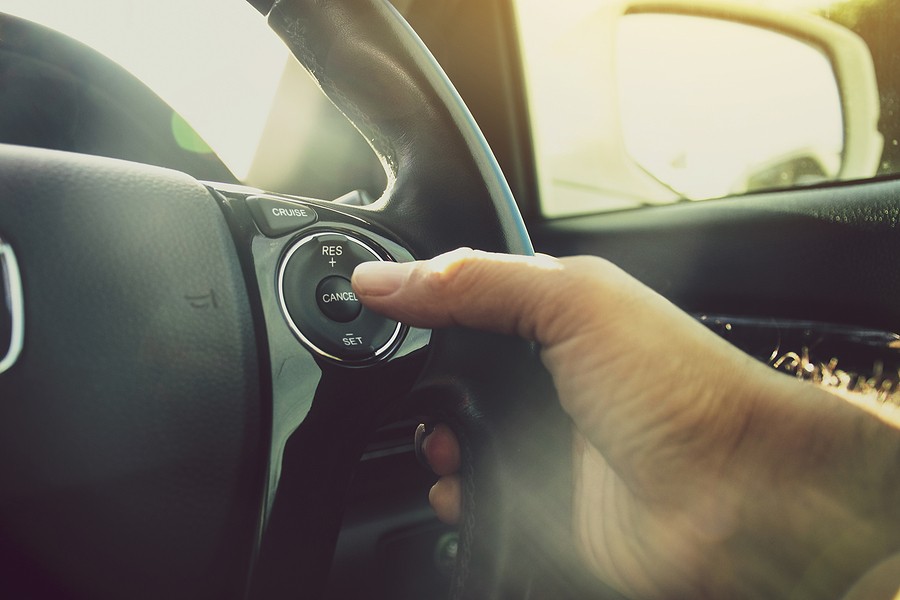
Some of the benefits of cruise control include:

- Less fuel consumption
- Less wear and tear
- Reduce speeding tickets
- Allow for more focus
- Better comfort
- No worries about disengaging
- Dynamic speed setup
- Great automatic parking
- Warnings for any forward collision
With the evolution of technology, vehicles now include many systems to provide the most comfort and the best safety. One of the very innovative technologies is cruise control. With this technology, drivers can now take off the gas pedal while driving at a steady speed.
There are tons of benefits to using cruise control and learning about them how to make the most benefits out of your vehicle systems.
This article walks you through the nine benefits of cruise control. It also highlights some of the general drawbacks of cruise control before engaging the system, along with situations where you cannot use the cruise control.
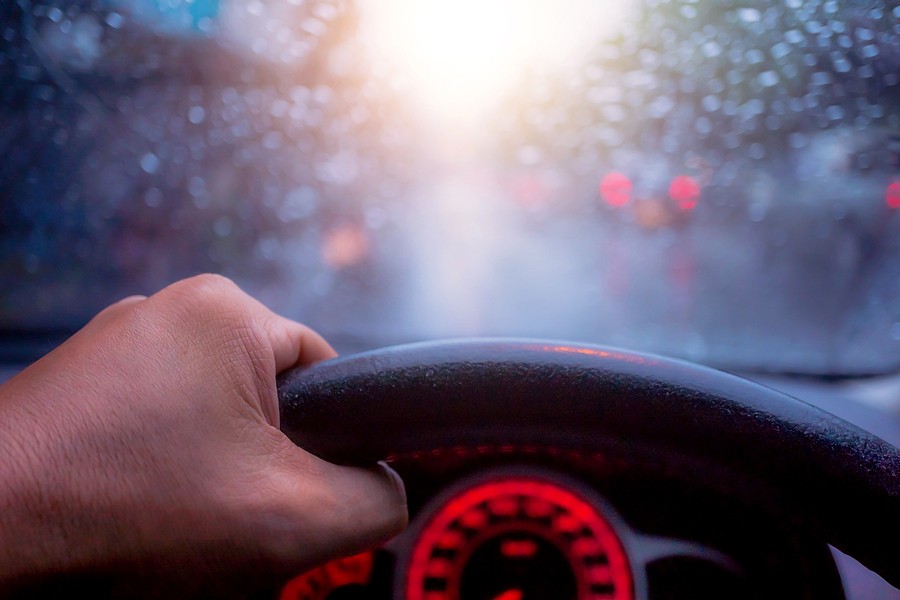
What is the cruise control, and what is it used for?
Before we dive into the benefits of cruise control, we must understand what this system is and what it does in the first place.
Cruise control is an added technology to most modern vehicles that allow drivers to take their foot off the gas pedal while keeping the vehicle driving at a constant speed.
Some additions and advancements to this cruise control allow it to adjust the speed depending on the traffic by relying on several sensors.
There are a lot of benefits and advantages achieved from utilizing the system, but there are some drawbacks to keep watch for and consider before deciding to engage the system.

9 benefits of cruise control
Many drivers are aware that their vehicles are equipped off cruise controls, but they don't fully understand the main benefits of this system. Therefore, to use the most out of your car and enjoy the best benefits, you must understand the main benefits of cruise control.
Let's take a closer look at what automotive experts put together as the main benefits of cruise control:
1. Less fuel consumption
The first and best benefit of utilizing cruise control is saving on fuel. Who doesn't want to save on fuel, especially with the increase and skyrocketing gas prices in 2022?!
If you think about it, cruise control allows you to drive at that steady state speed which means you don't have to press the gas pedal between now and then to increase and adjust the speed frequently.
Every time you hit the gas pedal, you consume more fuel, and sometimes this fuel might be beyond what your vehicle needs to drive at a certain speed.
Therefore, the less you hit the gas pedal, the easier it is for your vehicle to decide on how much fuel to use, so it uses the minimum required versus wasting this fuel for nothing.
2. Less wear and tear
The only thing is that cruise control reduces the stress and fatigue on your vehicle. Therefore, your car doesn't have to work hard every time you press on the gas paddle, and you don't need additional work from your engine to generate the required energy you're looking for.
The vehicle will drive and generate energy depending on how much it means and therefore cannot. So, the engine doesn't have to work hard and will know when to produce energy versus how much extra energy you put every time you change the speed.
This all is done internally and smartly using a combination of sensors, and this is used in most modern vehicles, but it might not be the case in every vehicle with a regular cruise control System type.
3. Reduce speeding tickets
Obviously, if you intentionally set the cruise control, you know that you're setting the right speed and you'll never set it at a higher speed than what the road regulations are asking for.
Therefore, many drivers mentioned that they do not have to worry about extra speeding tickets because they usually drive using cruise control on the highway. This system forces them to drive at the required speed and never Overspeed.
Who doesn't want to enjoy this benefit?! It is a huge plus of cruise control to eliminate and prevent these speeding tickets as much as possible.
4. Allow for more focus
When you engage the cruise control, you allow yourself more focus. Instead of focusing on multiple things simultaneously, now you have some help to maintain the drive speed and press on the gas pedal instead of focusing on your foot and requesting more fuels to be sent to the engine.
At this point, you have more focus to see what's going on on the road and how to steer properly and keep your eye on some of these surroundings that might pop up suddenly so you can drive safely and prevent dealing with major car accidents.
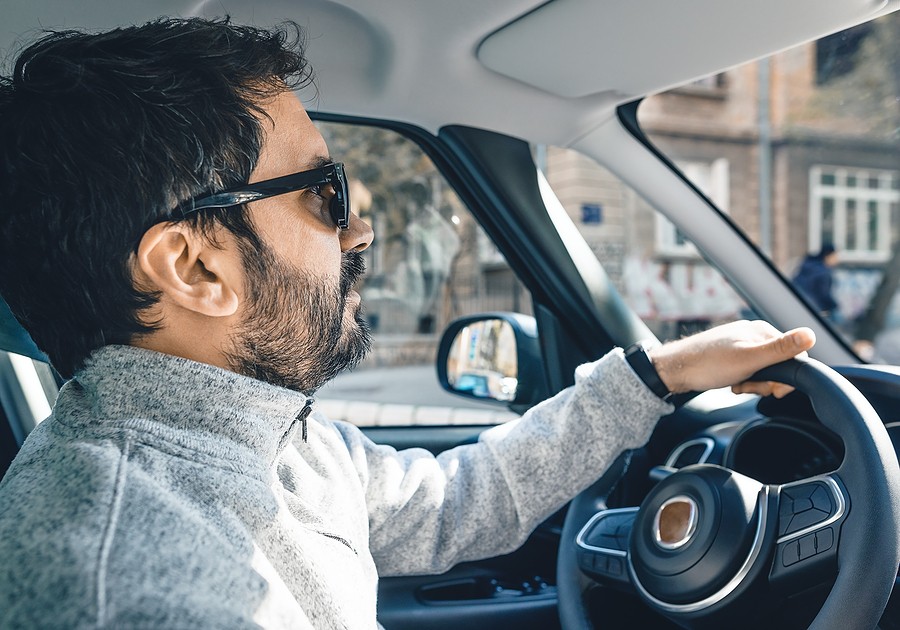
5. Better comfort
Imagine if you're driving a very long distance for a road trip or something like this, you will be continuously pressing on the gas pedal, which can be a lot of stress and pressure on your foot.
By engaging the cruise control, you will provide more comfort and allow your body to relax rather than constantly being under pressure as you're driving. Therefore, the driving experience would be much better and more comfortable going through longer distances and enjoying road trips more than before.
6. No worries about disengaging
Some drivers might be worried about the way you disengage the cruise control. In other words, they will think that it'll take some time for your vehicle to release the Cruise control and used to control the car, which can sound like a scary, risky situation.
The good news is that disengaging the cruise control is very simple, and all it takes is just a clickable button where you switch from relying on the cruise control to control your car versus your foot to send the required fuel to your engine.
Thus, don't worry about sudden situations where traffic changes or something happens that you're not prepared for on the road.
7. Dynamic speed setup
There are more modern vehicles that even took it to the next level. For example, these cars have a dynamic speed setup where the vehicle changes the speed by itself without your input to adjust to the road.
These vehicles are very smart and lot uncomplicated sensors that adjust the speed depending on how many vehicles are around you and what speed makes the most sense to keep you safe while driving you to get from point A to point B without being late or without wasting any time or energy.
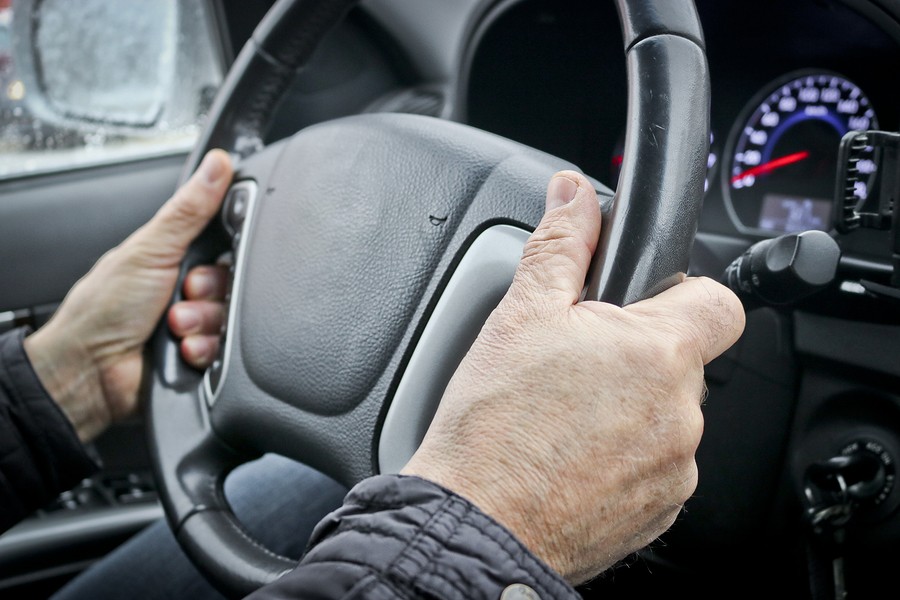
8. Great automatic parking
Furthermore, some vehicles are equipped with additional options that allow the cruise control to plan for automatic parking if the traffic changes drastically as you're driving.
For example, suppose you were driving at a steady state speed, and suddenly the driver in front of you decided to stop. In that case, the cruise control will detect how close the front vehicle is to you and, therefore, will stop immediately to save you and prevent any major or minor car crashes.
9. Warnings for any forward collision
Finally, there are even more advanced cruise control systems with certain sensors to help detect any forward collision; it gives you some warnings that bring your attention as you get closer to that vehicle in front of you.
This feature makes driving safer and reduces the number of reported accidents as much as possible.
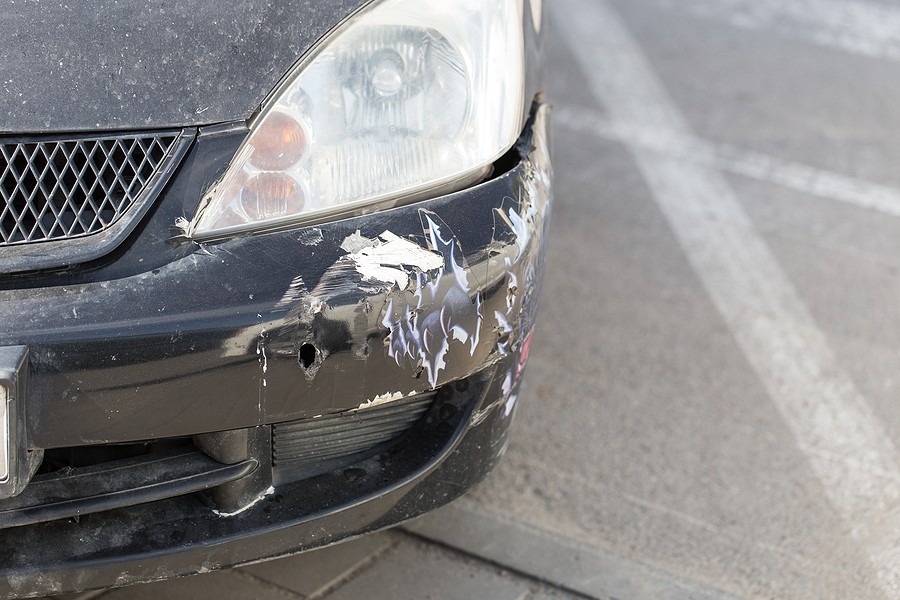
When not to use the cruise control?
Despite the great features that you might be attracted to from cruise control, there are situations that you have to be very careful about and never engage in cruise control.
Let's take a closer look at some of these situations :
1. Slippery roads
One of the first recommendations you will hear from most automotive experts is never to engage the cruise control when driving on slippery roads. By engaging the cruise control, there is a risk that your vehicle might hydroplane and act very weird, which could get you involved in major complications and car crashes.
2. Drowsy drivers
If you're not feeling good and think cruise control will take over, why are you not focusing? That's not a good idea. Cruise control is not a self-driving system, so you must focus fully on the roads when engaging, even if driving at the right speed.
The purpose of cruise control, as we mentioned earlier, is to release the pressure on your foot when pressing on the gas pedal for a long distance.
3. City roads
Cruise control does not make sense when you're driving during city hours. Typically, during city rose, you want to stop and go multiple times on stop signs which means this system will not work effectively because you're going to engage your votes between now and then at very short distances.
Most automotive experts recommend using this system only for longer distances driving at highway speed.
4. Heavy traffic
Even if you're driving on the highway and there is heavy traffic, you cannot use the cruise control effectively because you will not get the most benefit out of it. When there's too much traffic, these highways will turn like city roads and look like you're driving and stopping on stop signs multiple times.
Therefore, engaging the system might not be worth it because it will take you more time and effort to engage and disengage the system so you can't drive your vehicle yourself and decide when to stop and move.
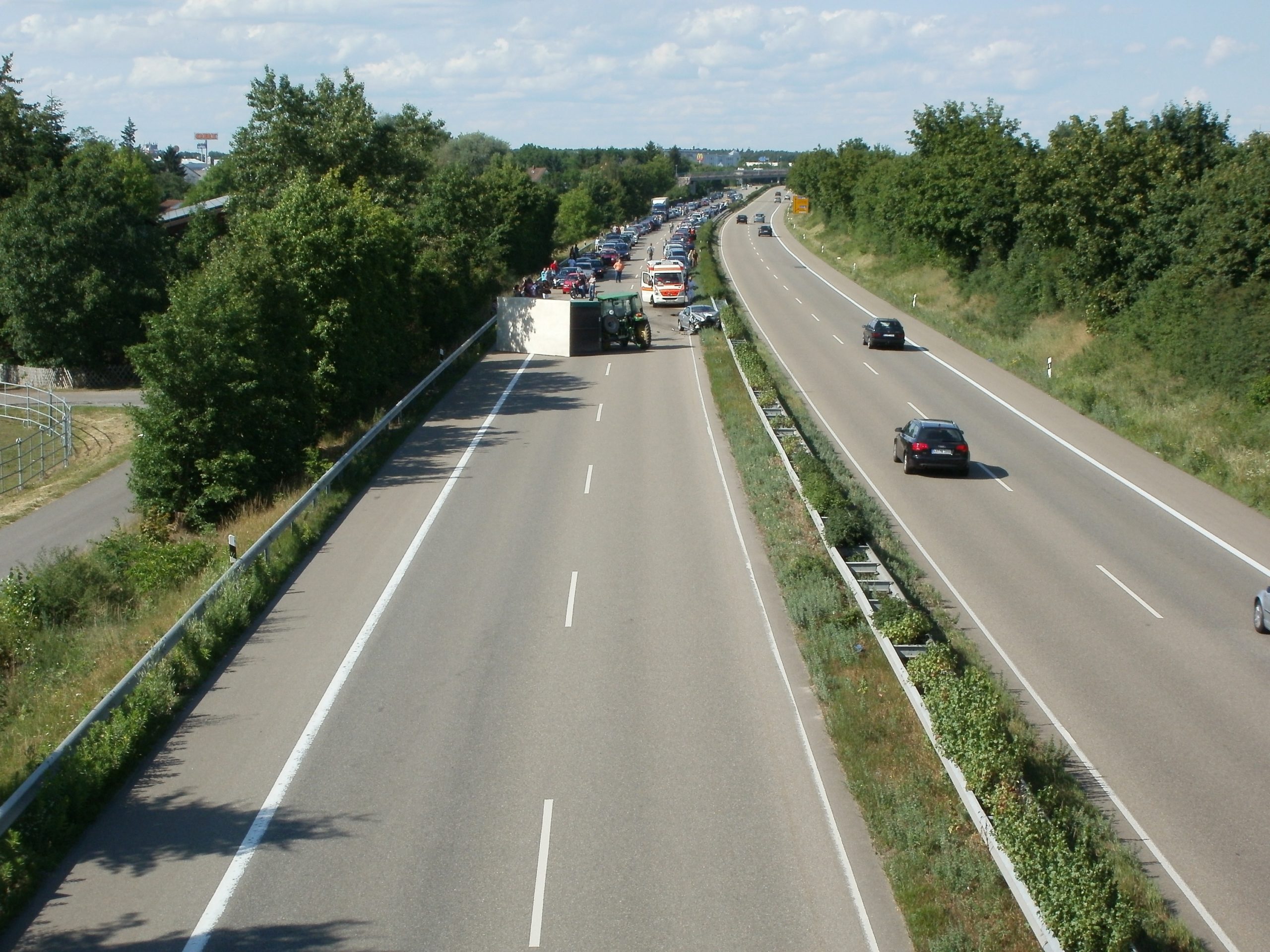
Disadvantages of cruise control
Although there are many advantages of utilizing cruise control most of the time, There are multiple drawbacks to watch for before engaging the system so you don't involve in safety situations that could put your life at risk and other people driving around you.
Believe it or not, although the main purpose of utilizing the cruise control is to enhance your safety, some drivers use it during the wrong time. For example, many drivers rely on cruise control as a good way to drive and take over the roads while they're not focused. Unfortunately, when drowsy drivers rely on this system, the chances of major car crashes can be very high.
Final thoughts
Cruise control is one of the most innovative features added to vehicles. It allows drivers to drive as constant speeds and reduces the stress on your foot. In addition, there are tons of benefits of a cruise control that you should familiarize yourself with, so you can get the most out of the vehicle's features.
This article highlighted those nine most common benefits of cruise control and provided you with situations where you should not utilize cruise control to avoid risks of crashes and other safety situations.
If your vehicle is not equipped with cruise control and you're interested in one, it could be a great time to sell this old car and buy a better one with more advanced technology. Are you looking for someone to buy your vehicle? Cash cars buyer can always help!
Cash Cars Buyer is one of the top-rated car removal companies in the nation that guarantees to pay you the top dollars and provide you with free towing despite your living location around the United States.
Our process is very straightforward and doesn't take more than a couple of days to get your car removed safely and for the most money.
All it takes you is to:
- Describe your car's type and condition
- Receive our instant free quote
- Accept the quote
- Get your car removed and receive your cash payment on the spot !
To learn more about our process and our team, you can reach out to us by calling us at (866) 924-4608 or by visiting our home page click on the free instant online offer.
Recent Posts
Carmax hidden fees when selling a car: a comprehensive guide, how much is a car with a blown head gasket worth an expert’s insight, subaru reliability myth: a comprehensive analysis, cost to replace an alternator: a complete guide, weight of a gallon of gas: a comprehensive guide, how much does it cost to patch a tire an in-depth guide, check vsc lexus: a comprehensive guide to understanding and resolving the issue, how much to fix an ac in cars a comprehensive guidance, oil pan gasket replacement cost: everything you need to know, control arm replacement cost: everything you need to know, 2014 ford focus transmission: a comprehensive guide and solutions, 4.7 dodge engine: all what you need to know, how much to patch a tire – the ultimate guide, rattling sound when accelerating: a comprehensive guide, bug bomb for cars: effective solutions for bug control, coolant leak repair cost: everything you need to know, spark plugs replacement cost: the complete guide, double cab vs crew cab: comprehensive guide to make the right choice, offerup cars: maximizing your success with this comprehensive guide, selling a car to a friend for $1: a comprehensive guide.

Certified by the Saudi Authority for Accredited Residents
- Saturday to Thursday from 8 AM - 10 PM
- Friday from 2 PM - 10 PM
- [email protected]

Cartech Company for Vehicle Services

Latest News :

What are the advantages and disadvantages of “cruise control” in the car?
- August 8, 2021
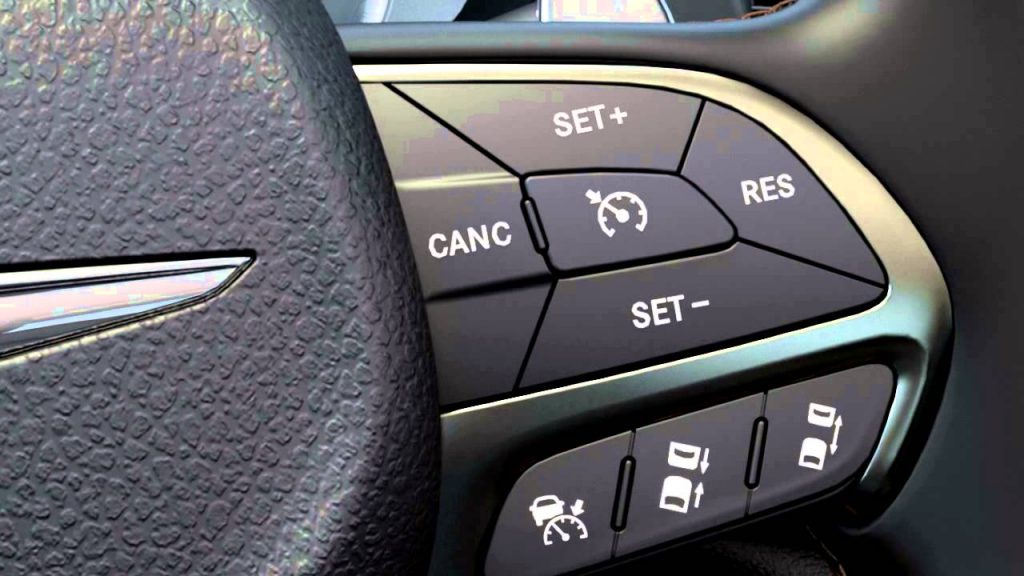
Cruise control is one of the modern systems in cars that help provide the driver with comfort while driving, especially when traveling. Some international car companies offer cruise control as a standard in their cars, while other companies offer it within the packages of additional equipment.
Despite the importance of cruise control and its many advantages, it can be very dangerous if used incorrectly.
Through the following report, it is possible to identify the most prominent advantages of cruise control and the risks of using it in the wrong way:
First – the advantages: Providing comfort to the driver while driving, especially when driving long distances
- Reducing the fuel consumption of the car Reducing emissions from exhaust, which reduces environmental pollution Long-term maintenance of the car
- Reducing the commission of traffic violations, as the cruise control works not to exceed the prescribed speeds according to the road.
Second – defects: If you feel tired and exhausted, it is advised not to use it, as it helps you sleep while driving.
- Be careful on strong curves if installed at high speeds, as the operation of this system leads to slow and obstruction of the brake system.
- The cruise control system may malfunction in very rare cases, putting the driver and passengers at risk. Avoid using this feature on wet or unpaved roads, in order to avoid slips or misalignment of the steering wheel.
We provide our customers with comprehensive and professional services

Cartech Center for Vehicle Damage Estimation
Mohamed Ben Alalaa St., Al Riyadh, Al Manar District
Cartech Services
Cartech gallery, all rights reserved to cartech company branch for vehicle services 2021.
Aftermarket Cruise Control Cost [Multiple Models]
Maybe you bought your car or truck without cruise control, and now you think you would like to have one added, but you are not sure how much an aftermarket cruise control will cost.
Purchasing and installing an aftermarket cruise control cost will essentially be dependent upon the vehicle you are trying to install the system on and its requirements.
You should expect to pay a minimum of $190 to $375 for a non-adaptive aftermarket cruise control unit plus labor. Labor to install the unit can be as low as $55 to $70 and up to $250 to $300.
If you buy an adaptive cruise control, you can expect up to $2500 for an aftermarket cruise system depending on what benefits you want.
These aftermarket cruise systems are off Amazon and are plain aftermarket cruise systems that are not adaptive, typically much higher as described below.
Cruise controls like everything else have evolved and gotten much better over time. Now, most vehicles can come with adaptive cruise control.
What is adaptive cruise control? How does it work, and why would you want to pay more than regular aftermarket cruise control, which costs much less?
Cruise Control
When cruise control first came out, it allowed you to set your speed and remain at a constant speed without having to keep your foot on the gas pedal all the time so that you could rest your leg.
It also helped people who had trouble keeping their speed within limits from constantly getting tickets.
It was entirely up to the driver to keep a safe distance from other cars and know when to adjust his speed. Drivers also had to resume the speed after slowing down manually.
Adaptive Cruise Control
They designed adaptive cruise control to help vehicles on cruise control maintain a safer distance between themselves and other cars on the highway while still maintaining the speed limit.
The care knows when to adjust your car’s speed without you having to slow yourself down physically. You may have it called by another name, such as intelligent cruise control or dynamic cruise control.
Is it Safe to Use an Adaptive Cruise Control System on Your Car?
It is perfectly safe to use an adaptive cruise control system on your vehicle as long as you remain in control of your car at all times.
You can rest your leg and rely on the system as long as you stay alert and watch for problems that might pop up suddenly. Remember, no autonomous system works 100 percent accurately.
Weather and other conditions can limit the accuracy of assisted programs. A car speeding by too fast may not pick up on blind-spot monitoring. Stay ready to take control if needed actively.
How to Set Cruise Control
Setting cruise control is relatively easy. Start by turning it on. You must get the car’s speed over a minimum threshold, and then once you reach the speed, you want you set it by pushing the button.
To slow down or stop cruise temporarily, you tap your brakes.
Advantages of Adaptive Cruise Control
There are some advantages to adaptive cruise control that make it worth the extra cost of adding to a vehicle that does not have any cruise control.
The most important of which is road safety. Cars with adaptive cruise control technology will automatically keep adequate spacing from other cars and trucks on the road.
Adaptive cruise control uses cameras, lasers, and radar equipment to tell how close cars are to each other and other objects on the road. It alerts the driver with red flashing lights to the impending dangers ahead.
It will also say “Brake Now” on the dashboard. Some systems even have an audible warning to get the driver’s attention.
Making sure that the vehicles stay a safe distance apart helps prevent accidents while maximizing traffic flow at the same time.
The driver doesn’t have to worry about maintaining speed or slowing when needed and can concentrate on what is going on around them.
Limitations of Adaptive Cruise Control
The adaptive cruise control system is not entirely autonomous, so the driver must use safe driving practices to prevent wrecks.
Certain weather conditions such as snow, rain, or fog can confuse the system’s sensors making it hard for the system to judge distance as well as in normal conditions.
Unusual things like tunnels can also make the sensors react less accurately.
Types of Systems of Adaptive Cruise Control
There are several types of adaptive cruise control systems, including:
Radar-Based Systems
- Assisting Systems
Laser-Based Systems
Binocular computer visions systems, predictive systems, multi-sensor systems.
Adaptive cruise control systems that are radar-based can work because they place sensors around and on plastic fascias to help figure out where and what surrounds your vehicle.
All the radars work together to help create a comprehensive picture of your car’s proximity to the other cars near it. It can also detect dangerous things on the road.
Laser-based systems typically operate out of a big black box placed into the grill of your car or truck that uses laser technology to detect the distance objects are to your vehicle.
The laser-based system, however, does not always work well in bad weather conditions.
This technology uses small cameras in your rearview mirror to look for objects facing your vehicle from behind.
Predictive systems are a type of adaptive cruise system that uses sensory data to help it predict what other vehicles near your car will probably do.
If your truck indicates traffic is fixing to slow down, it may slow your vehicle to prevent a wreck. Companies are constantly upgrading this technology to improve the safety of everyone on the road.
Some adaptive cruise systems use more than one type of sensor to help provide a more cohesive experience and promote a safer environment.
Using more than one makes sense to help give the best picture of what is going on around your car when it is on the road.
The more accurate data gathered by your sensors, the better protection for you, your family, and everyone on the road near your vehicle will be.
Adaptive Cruise Control Paired with Other Capabilities or Assisted Systems
You can add several things to go with your adaptive cruise control to make your driving experience safer and more pleasant.
Lane Centering Technology. Lane Departure Warning and Lane Keeping Assistance
These three assisted systems are great at keeping your vehicle where it needs to be. They help keep you from drifting or driving off the road.
You can purchase all of these three together for just under $1000.
Lane Centering Technology
The lane-centering add-on helps you stay in your line between the lines. Unlike some technologies where the car makes corrections for you, this technology monitor and alerts the driver.
The driver has to correct any issues themselves. A potential problem is if the lanes are not marked. It cannot read what it cannot see.
Sometimes it has issues in bad weather such as rain or snow. If your blinker is on, it doesn’t warn you because it thinks you are turning or moving to another lane.
Lane Departure Warning Monitor
The lane departure warning monitors the position of your vehicle within the driving lane. It alerts the driver if the car approaches or crosses into another lane or the shoulder.
The system kicks in at between 30 to 40 miles per hour. The system gives an audible warning when your car crosses a solid or dotted line. Some systems vibrate the steering wheel to get your attention that you are drifting out of your lane.
The windshield camera is mounted high up in the windshield of a lane departure warning system. The camera can get a view of the road at least 150 feet in front of the vehicle.
If the car veers in either direction between the two lanes, a warning is given to the driver by visual alert, and probably an audio one, a vibration in the steering wheel, or the set might vibrate.
Lane-Keeping Assistance
The lane-keeping assistance helps keep the car steering within the lane. If you let the car drift too far to one side, the system steers your vehicle away from the edge of the lane.
Then you have to recenter the vehicle in the lane.
Blind Spot Monitoring
Designed to add safety while driving, blind-spot monitoring systems use radar to detect other vehicles traveling in the lanes next to your car.
Typically, you will see notifications on or near your mirror on the side of the vehicle where a vehicle is in your blind spot.
Generally, if you turn on a blinker indicating you are changing lanes, the light will start flashing to get your attention. Some vehicles will also have an audible alert.
Some blind-spot monitoring systems are more accurate than others. Systems using microwave sensor blind spot detection systems give drivers a much better response time than ultrasonic systems.
Ultrasonic systems sometimes have trouble differentiating between cars and trees or other objects on the side of the road. You can get this add-on for around $750.
Other Systems Available
Several other assisted systems that are compatible with your adaptive cruise control system that is designed to protect you and your family include:
Older cars and trucks will not have any of these things available without aftermarket installation.
However, newer models may come with some if not all of these add-ons, or you can ask for them to see if they are available on your new vehicle.
The costs will vary depending on the car you want them installed onto and the company you choose to buy them.
Installation costs will also vary depending on how many modifications your vehicle needs and the rate per hour the shop you select charges for labor.
Automatic or Manual Transmission
You can usually install an adaptive cruise control on both manual and automatic transmission vehicles. However, you may not get much out of manual cruise control in town.
When you remain in top gear for more extended periods on the highway, you can get a lot of use and savings on fuel by having adaptive cruise control.
In town, you will be disengaging your cruise every time you clutch, not just when you break.
Depending on your car and the brand you buy of aftermarket cruise control, you may need a clutch disengagement switch for a manual transmission.
Adaptive Cruise Control for Motorcycles
You can even install an aftermarket cruise control for your motorcycle. The cruise control system costs around $550 if you install it yourself.
It is a rather large control switch for a bike but works great when installed correctly.
They are very accurate and smooth. The McCruise cruise control system is compatible with most bikes and is priced at $550 without installation.
McCruise is throttle-by-wire compatible. Many others on the market have cable-operated throttle assemblies, so you will need to figure out which one you need.
To Conclude
Getting an aftermarket adaptive cruise control system can unlock some pretty impressive technology to help protect your family.
Units cost between $500 and $2500 depending on what type of car you have and the add-ons you select. And labor costs to install your systems.
Even if your car had no option for a cruise control system, many companies offer aftermarket adaptive cruise systems for most cars and trucks on the market.
Motorcycles can also have installed aftermarket cruise control systems to them, as well. The different technology helps make your vehicle safer for you, your family, and those driving around you.
Scott Brown is not just your run-of-the-mill automotive enthusiast. He's a dedicated and highly skilled individual who has dedicated over 15 years of his life to the intricate world of diesel engines. Born into a family of automotive aficionados, his journey into the world of engines and automobiles starte... Read More
Leave a Reply Cancel Reply
Your email address will not be published. Required fields are marked *
Save my name, email, and website in this browser for the next time I comment.
Do Bikes Have Cruise Control: Exploring the Possibilities and Limitations
Cruise control is a crucial feature in modern cars, allowing the driver to maintain a constant speed without constantly maneuvering the pedals. This feature has become increasingly popular due to its convenience and ease of use, leading many cyclists to wonder if the same technology can be incorporated into their bikes.
While cruising on a bike may not be as simple as in a car, there are several possibilities and limitations of adding cruise control to a bike that cyclists should be aware of. In this article, we explore the potential benefits and drawbacks of integrating cruise control into bikes, and examine the challenges manufacturers face in bringing this technology to market.
Table of Contents
The Basics of Cruise Control: How it Works
Cruise control is a technology designed to maintain a constant speed of a vehicle without the need for the driver to constantly adjust the accelerator pedal. When engaged, the system electronically monitors the vehicle’s speed and automatically adjusts the throttle to maintain a constant speed set by the driver. This allows the driver to relax and keep their attention focused on the road rather than constantly monitoring their speed.
Cruise control is typically used on cars and other motor vehicles, but the question remains – do bikes have cruise control too? While some high-end motorcycles do feature cruise control systems, they are not nearly as common as they are on cars. Additionally, there are some important differences to consider when it comes to implementing cruise control on a motorcycle.
Read Also: Is a Beach Cruiser Bike Good for Exercise? Maximizing Your Workout on a Beach Cruiser
The Pros and Cons of Bikes with Cruise Control
Bikes with cruise control have their advantages and disadvantages. The most significant advantage is that they provide a comfortable ride on long trips. With cruise control, the rider can maintain a consistent speed without having to constantly keep their foot on the accelerator. This reduces rider fatigue and provides a more relaxed riding experience.
However, there are also some downsides to bikes with cruise control. The primary disadvantage is that they can be dangerous if not used properly. If the rider becomes too reliant on the cruise control, they may become complacent and fail to pay attention to the road. Additionally, some riders may find that using cruise control reduces their awareness of their surroundings, making it more difficult to react quickly in the event of an unexpected obstacle. Ultimately, while there are advantages, riders must remain cautious and aware of the potential risks when using cruise control.
Different Types of Bike Cruise Control Available in the Market
There are different types of bike cruise control available in the market that offer varying levels of functionality and convenience. The most common type of cruise control for bikes is the electronic or digital cruise control. This type of cruise control uses electronic sensors to monitor the speed of the bike and maintain a constant speed without the rider having to twist the throttle. Advanced versions of electronic cruise control also come with additional features, such as adaptive cruise control, which can adjust the speed of the bike based on the distance from the vehicle in front.
Another type of cruise control for bikes is the throttle lock. Throttle locks are mechanical devices that allow the rider to lock the throttle in a certain position, enabling them to maintain a constant speed without having to hold the throttle. However, throttle locks are not suitable for long distances or hilly terrains, as they can cause over-revving of the engine, wasting fuel and reducing engine life. Therefore, it is important to consider the type of bike and the terrain where the bike will be used before selecting the type of cruise control.
You may also like: Can Cruiser Bikes Go Fast? Understanding the Speed Capabilities of Cruiser Bicycles
Limitations of Bikes with Cruise Control
Despite the numerous benefits of having cruise control on bikes, there are still some limitations that come with this feature. One significant drawback is that it may not be suitable for some types of terrain, particularly in situations where the road is winding, with many curves and bends. Since the bike relies on a steady speed to maintain the cruise control feature, it can be challenging to maintain the same pace when navigating such terrains. Furthermore, steep hills and inclines may present difficulties since maintaining a steady speed is often difficult under such conditions.
Another limitation of bikes with cruise control is that the feature is not available on all types of bikes. Some motorcycles do not have this feature, which indicates that riders must check the specifications of their bike. Even if a bike has cruise control technology, it may be challenging to activate it, especially for new riders who may have never utilized it before. Riders must also understand the limitations of cruise control as it does not replace the need for caution and awareness when riding.
Safety Considerations for Using Cruise Control on a Bike
Using cruise control on a bike can be a convenient option for riders who want to maintain a steady speed on long journeys. However, it is crucial to consider certain safety aspects before engaging with this feature. Firstly, it is recommended that you test the cruise control feature on a less busy road or in an empty parking lot before using it on the highway. This way, you can become more familiar with how it works and ensure that you are comfortable with the additional control it provides.
Secondly, it is crucial to remember that you still have to remain vigilant while using the cruise control feature on a bike. You must always keep your hands on the handlebars and be ready to brake or accelerate if necessary, as situations can change rapidly on the road. Furthermore, be extra cautious about your surroundings and avoid using the cruise control feature in unpredictable weather or road conditions, such as heavy rain or strong winds. By exercising caution, you can safely and effectively use the cruise control feature on your bike.
Maintenance and Repair of Bike Cruise Control System
Maintenance and repair of bike cruise control system is crucial to ensure that the system operates smoothly and safely. Regular maintenance checks should be carried out to ensure that all components are functioning correctly and to identify any damage or wear and tear that may have occurred. This may include checking the throttle linkage, electrical connections, and servo motor operation.
In case of any issues, it is important to seek the services of a qualified professional to avoid causing further damage to the system. Repairs may include replacing broken components, recalibrating sensors, or resetting the system. In addition, keeping the bike clean and dry can help prevent corrosion and damage to the system. Regular maintenance and timely repairs can help extend the life of the bike cruise control system and ensure a safe and comfortable ride.
Related Post: Are Cruiser Bikes Good for Casual Riding? A Comprehensive Analysis
Future of Bike Cruise Control Technology and Innovations
Introduction:
Bike technology is advancing each day, and with the development of cruise control in automobiles, it is natural to wonder whether bikes will come equipped with cruise control features. In this subheading, we shall explore the future of bike cruise control technology and possible innovations that may improve the cruising experience for bike enthusiasts.
Future of Bike Cruise Control Technology:
As the demand for bike cruise control features increases, bike manufacturers are continually researching and developing cruise control bike models, which could be available in the near future. Some innovative enhancements include the use of electronics, sensors, and radar systems that can detect obstacles and adjust the bike’s speed or distance automatically. Other advancements in electric control system technology could use adaptive cruise control to independently adjust speed between other vehicles. While some skeptics may argue against implementing bike cruise control, safety, and the convenience of long-distance travels cannot be ignored, making bike cruise control innovations and technology worth exploring.
Final Words
In today’s world, where technology is advancing at an unprecedented rate, it is only natural to think that something as basic as cruise control would have made its way into the world of bicycles. Unfortunately, this is not the case. Bikes do not come equipped with cruise control, nor have any significant efforts been made to introduce this technology to the bicycle world.
However, this should not discourage us from enjoying biking. Bikes offer a simple, eco-friendly, and healthy mode of transportation that will continue to persist despite the lack of cruise control. While it may take a little more effort, it can also be immensely rewarding. Therefore, instead of focusing on the technological limitations, let us embrace the joy of biking and the freedom it offers.
Leave a Comment Cancel reply
Save my name, email, and website in this browser for the next time I comment.

COMMENTS
The cruise control system relies on a speedometer and a servo mechanism to work. When you set a speed, the system maintains it by controlling the throttle. If your car goes slower than the set speed, like going up a hill, the system increases throttle to speed up. ... Understand its limitations: Cruise control cannot recognize stop signs ...
Cruise control is a system that almost every modern vehicle on the road today has as a feature. The purpose of the cruise control system is to give drivers the ability to automatically set and maintain a specific vehicle speed. ... This is even more important when utilizing cruise control. Top 4 Cruise Control Disadvantages. 1) Bad for Tired ...
Like any safety or convenience system, adaptive cruise control has limitations. As with standard cruise control, the driver is required to steer the vehicle, although many vehicles make this task ...
When you use cruise control, you are no longer giving your full mental and physical attention to the task of driving. When driving on straight stretches of road with cruise control activated, you may not even need to steer constantly. That can increase your risk of daydreaming, becoming distracted, or suffering from "highway hypnosis"—all ...
Each type of cruise control system has its own advantages and disadvantages, and drivers should choose the one that best suits their needs. What Is Cruise Control. Cruise control is a system within a vehicle that enables drivers to establish and sustain a specific speed without having to continuously press the accelerator pedal.
Types of Cruise Control: Traditional Cruise Control: This basic system uses a simple electronic control unit to regulate the throttle. Adaptive Cruise Control (ACC): This advanced system uses radar, lidar, or cameras to detect the distance and speed of surrounding vehicles, adjusting the speed accordingly. Radar Cruise Control: This system uses radar sensors to detect obstacles and adjust the ...
The cons or disadvantages of cruise control are: Drowsiness Danger: The hypnotic hum of constant speed can lull even the most alert driver into a false sense of security. Remember, cruise control doesn't replace the need for active engagement and vigilance. Road Reality Check: Cruise control isn't a one-size-fits-all solution. It struggles on ...
The pros of cruise control: Easier on the joints on long journeys. Allows you to maintain a steady, legal speed so you are less likely to accidentally edge over the limit. Increased fuel efficiency thanks to the consistent speed. The cons of using cruise control: Speed control is great - when used in the right situation.
Basic systems are usually operated by a control either on the steering wheel or a steering column stalk. Cruise control consists of an up/down (or +/-) control, as well as a 'Set' button, a ...
The Cruise Control is a system capable of automatically maintaining the desired speed (i.e., speed set by the driver) without pressing the accelerator pedal. This system is beneficial while driving at a constant speed as it significantly reduces driver fatigue.
Adaptive cruise control does have limitations—it's crucial to understand how the system operates in various traffic scenarios and what its boundaries are. It's not a substitute for our attention or a replacement for defensive driving. In particularly complex driving situations, such as inclement weather or unstructured road environments ...
0:54. Most drivers don't understand the limitations of advanced safety technology installed on new vehicles, according to a new study by AAA Foundation for Traffic Safety. The study indicates that ...
Esurance noted that by setting your cruise control to 60 mph you would improve your fuel efficiency by an average of 17.2 percent. Disadvantages of Cruise Control. Although cruise control can make a long highway trip more enjoyable, it can also reduce your reaction time while driving and impair your ability to safely change lanes.
Cruise control and speed limiter are often combined into one device. - The speed limiter makes it possible to program a maximum speed that you should not exceed. This system can thus avoid the loss of points and the associated fine in case of speeding. - The cruise control brings an additional aspect by regulating the speed along the route.
Here are some limitations of cruise control systems: 1. Curving Roads: Cruise control, especially Adaptive Cruise Control (ACC), primarily focuses on the forward view to detect vehicles. On curving roads, this system may encounter difficulty in accurately identifying traffic due to its limited frontward field of vision. 2.
A cruise control system's speed can be controlled with buttons on your steering wheel, giving you adaptive control on the road. More expensive cars are also equipped with adaptive cruise control, where this operation is done automatically. Disadvantages of cruise control in a car Limitations of Indian roads
Cruise Control - Pros & Cons. Cruise control is a smart feature in modern cars that lets you set a specific speed your car will maintain without you having to keep your foot on
7. * Cruise control is a system, which automatically controls the speed of an automobile. The system takes over the throttle of the car to maintain a steady speed as set by the driver. Most cruise control systems don't allow the use of cruise control below a certain speed. Blind inventor and mechanical engineer Ralph teetor invented cruise ...
Cruise control is not a self-driving system, so you must focus fully on the roads when engaging, even if driving at the right speed. The purpose of cruise control, as we mentioned earlier, is to release the pressure on your foot when pressing on the gas pedal for a long distance. 3. ... Disadvantages of cruise control.
Cruise control is one of the modern systems in cars that help provide the driver with comfort while driving, especially when traveling. Some international car companies offer cruise control as a standard in their cars, while other companies offer it within the packages of additional equipment. Despite the importance of cruise control and its many
Limitations of the system Smart Cruise Control system may have limits to its from SOC MISC at University of Winnipeg
If you buy an adaptive cruise control, you can expect up to $2500 for an aftermarket cruise system depending on what benefits you want. $375.25 + Labor between $55 and $250. $430.25 minimum to $625.25 on the high end with labor. $199.95 + Labor between $55 and $250. $254.95 Minimum to $449.95 on the high end with labor.
Bikes don't have cruise control in the traditional sense of the term as it's found in cars where it maintains a steady speed without any input from the driver. However, some bikes do come with electronic systems that allow the rider to set a desired speed and the system will maintain it without needing to constantly adjust the throttle. These are called electronic cruise control systems.